
The History of Doomsday: An interview with Emidln
Preface
I have been wanting to write this article for about four years now and before now, have been unable to realise my dream. As a player I properly finished Doomsday around 2014 however there was already a long history to the deck that has existed since the printing of our title card in the Weatherlight set in 1997. Despite playing through some significant printings, bannings, and changing metagames there has been one constant throughout the existence of the deck and that is one of the leading pioneers and early innovators of the deck: Brandon Emidln Adams (bja on MTGO).
I've been bothering him about various things since I took the deck up and he's always been available to answer (even if sometimes it took up to a year to do so ;) ). After four years of chasing I was finally able to get him in a room and get both a lot of detail on the history of the deck and learn a bit more about him as a player and his path onto the deck.
The entire interview is available on YouTube and SoundCloud.
Note: the raw video is over five hours long so is quite a journey. It also includes a lot of segways and general chatter however as I say in it: "the people who will be listening to this will enjoy a big ramble about Storm".
This article will detail the key points discussed and follow the history of the deck but will not be an accurate transcription of the interview. I will include quotes from the recordings but it will be written to stay more on target than our recorded discussion does. There is only a little overlap between this article and the recording so I would very much recommend you partake in both (though of course I am biased on this). I have tried to be as accurate as possible through online research however a lot of the pre-2007 information is hard to find or lost and piecing together accurate timelines is tricky. I also apologise if I mis-attribute anything, get an online handle wrong or omit someone very important. I have tried to get everything as correct as I can but it is far from perfect.
With that all clarified. let's get into it!
Who is Emidln?
Brandon Emidln (pronounced ee-mid-lin) Adams is a Legacy, Vintage and EDH
player best known for his historical and current work on the Doomsday Legacy
archetype. He started playing magic around 1997/1998 learning to play (with only
a slightly incorrect ruleset) from his cousin. His pet deck was a cheeky 72
cards ("you've got to fit all your best cards in somehow") and ran Shivan
Dragons and other creatures. As time went on, and new cards from Urza's
Legacy were printed, he actually already found a copy, and use for Doomsday in
his pile deck which he used to deploy a very efficient combo:
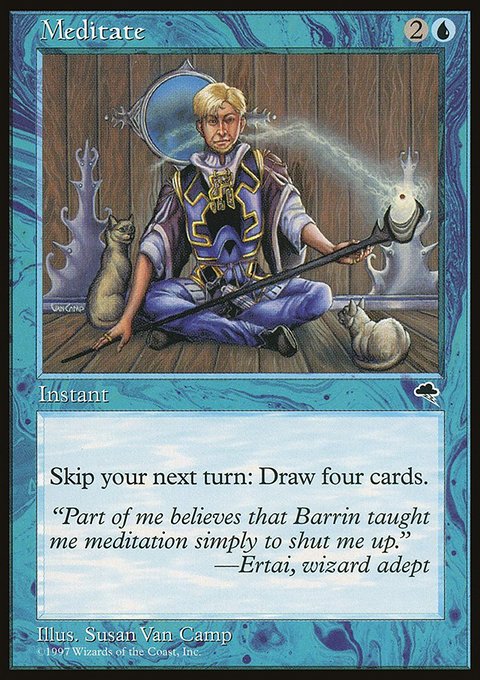
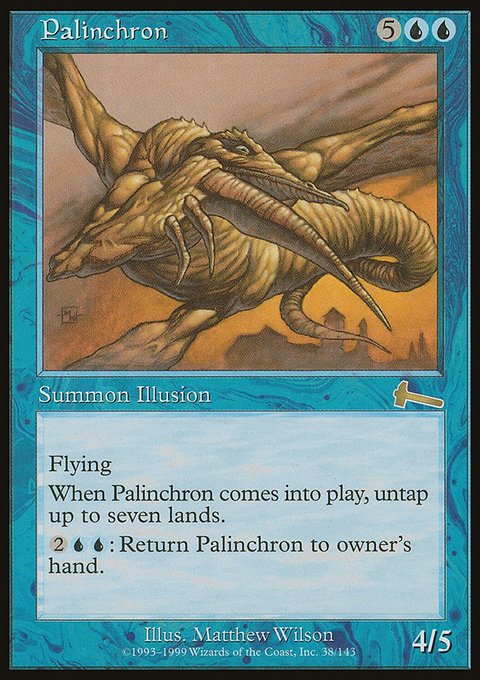
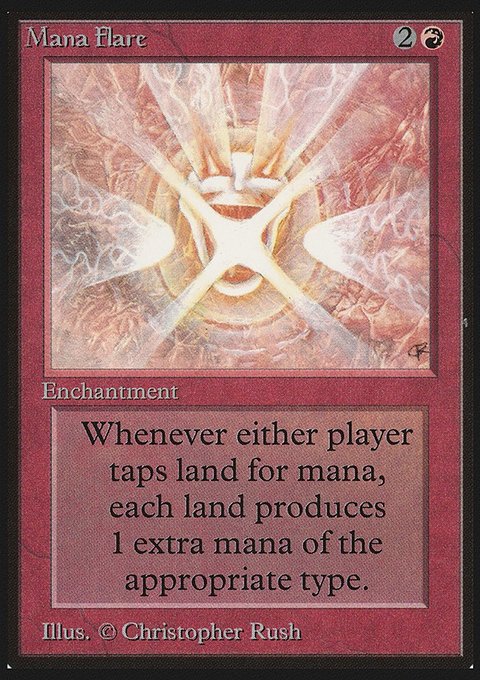


For only this would give you infinite mana to cast an exponentially large Stroke at your opponent. Pretty powerful magic.
Emidln eventually moved house, living in Chicago and visited the local game shop. There he brought along a powerful 64 card mono deck full of strong threats like Order of the Ebon Hand. He went 2-1 catching the eyes of some local players who offered sound advice like "play 60 cards" and "have real threats in there". From there he went to learn about Legacy and started to play the format. Initially he ran Smokestack based prison decks and slowly graduated into the combo side of things. First Iggy Pop (Ill-Gotten Gains Storm) and later on Spanish Inquisition (Mono Storm). Before we go into the next stage of his journey let us take a look at the start of the card Doomsday itself.
Pre-Legacy Doomsdays (The Days of Type 1/1.5)
Doomsday was printed in 1997 and has always had a bit of a cult following. The primary enabler for it in the form of Dark Ritual already existed in the format making it a very mana efficient play. There were also plenty of ways of finding it in the form of Mystical Tutor and Vampiric Tutor available (Demonic Tutor was restricted/banned in T1/T1.5 respectively). The earliest tournament style decks I can find were Type 1 legal only and built themselves to loop Timetwister in order to net mana each re-casting to then cast a lethal Braingeyser or other {x} spell.
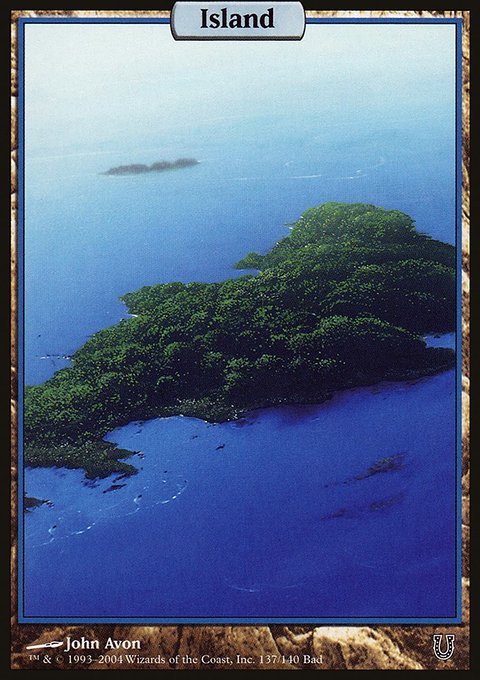
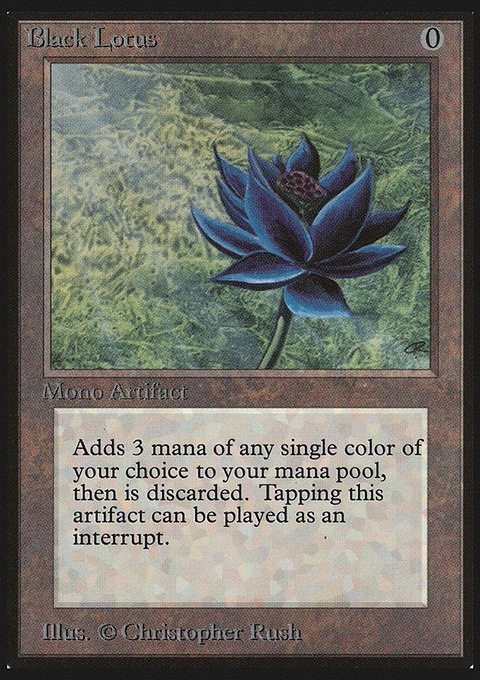
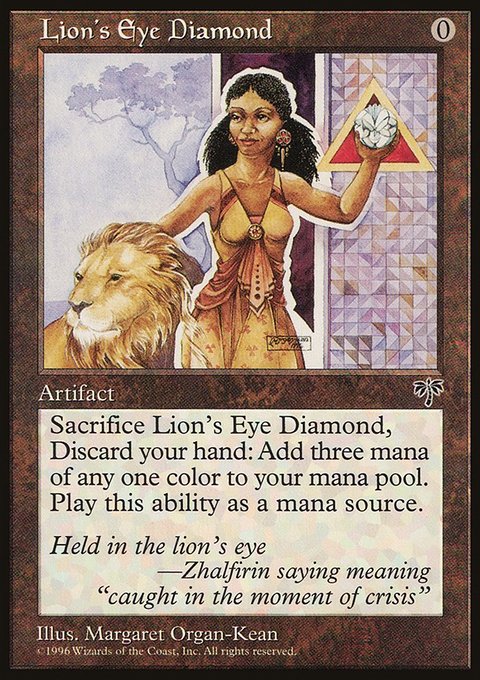
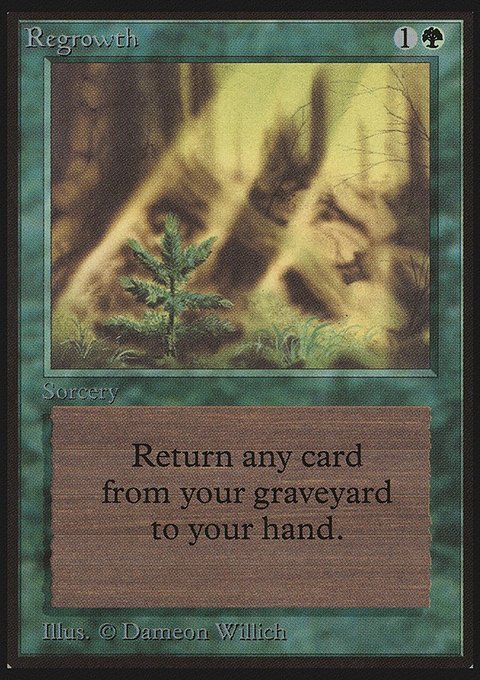
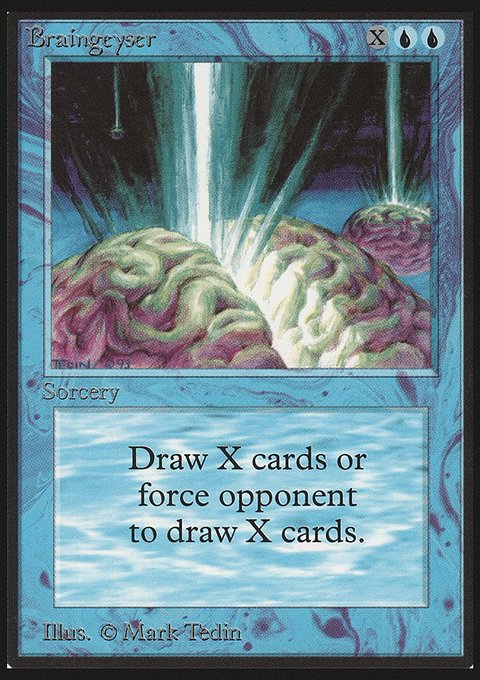
The pile required Timetwister and 2 other cards in hand along with for Regrowth. The Island could be replaced with any card as the idea was to crack into the pile with your draw 7 anyway. As 1998 - 1999 came around the deck got better obtaining cards like Duress, Lotus Petal, Brainstorm, Gush and Yawgmoth's Will however this resulted in a huge wave of bannings/restrictions in September 1999 which included Doomsday itself! As a result, the deck did not really feature in Type 1.5 at all and was fairly fringe in Type 1 where it could still see play as a singleton. This status doesn't really change until we fast forward a number of years to 2004 where a format divergence occurred.
Prior to 2004 Type 1 and Type 1.5 had effectively shared a ban list. Any cards restricted in Type 1 were automatically banned in Type 1.5. In September 2004 an announcement was made whereby it was stated:
The "Type 1.5" Banned List is now maintained separately from the Vintage Banned and Restricted Lists. This format is going to be renamed.
The format was subsequently decided to be named Legacy and from that moment on, the format's became independant of one another. Along with this format change a number of cards that were previously banned in Type 1.5 were taken off the ban list into Legacy. These notably included Burning Wish, Chrome Mox, Lion's Eye Diamond, Lotus Petal, Mystical Tutor and Doomsday. In 2005 there was also an unrestriction of Doomsday from the Vintage restricted list. This allowed Vintage pioneers like Stephen Menendian and Team Meandeck to develop a storm based Doomsday deck that made use of Tendrils of Agony, Gush combined with Fastbond and a cool kill involving Mind's Desire into Beacon of Destruction.
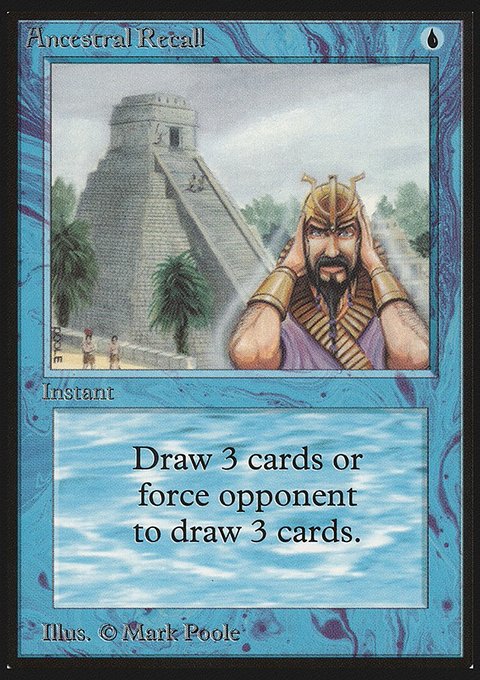

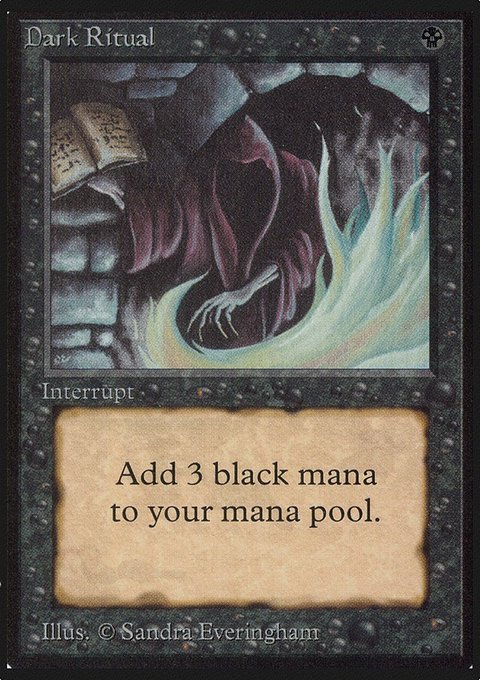
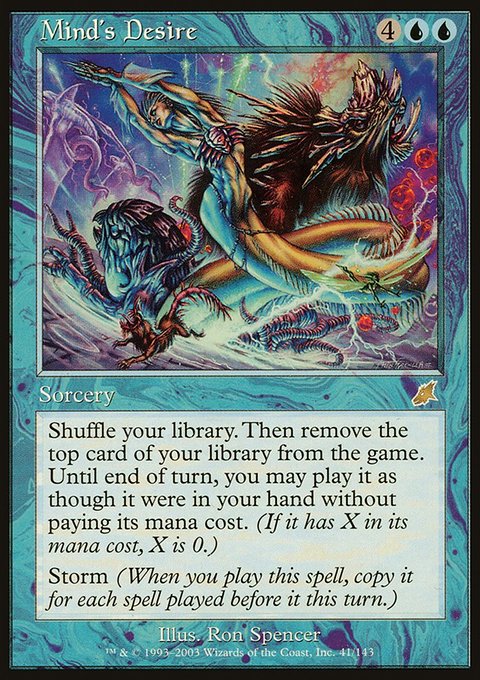
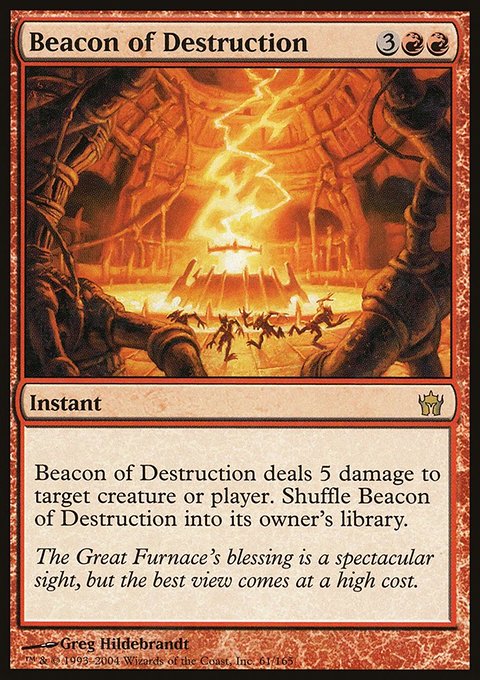
This pile was a pass-the-turn pile that cost to enact. It gave a storm of 4 which allowed you to cast Desire into Beacon, cast the Beacon with the other copies of Desire on the stack which shuffled itself back into the deck to then resolve the next copy of Desire. You can find more information on Vintage Doomsday from a number of sources but that is not our focus today!
The Start of Legacy - Early Doomsday Lists
When Legacy first began there was some interest pocketed around about trying to build a Doomsday deck. Some tried to mimick what a lot of Storm decks at the time were doing building piles like:
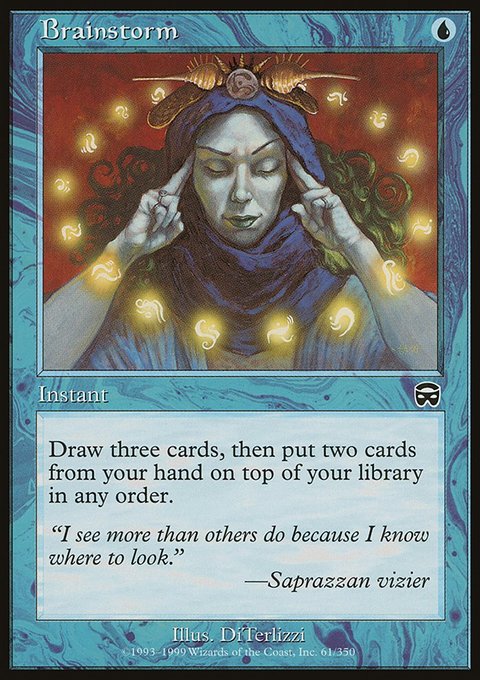



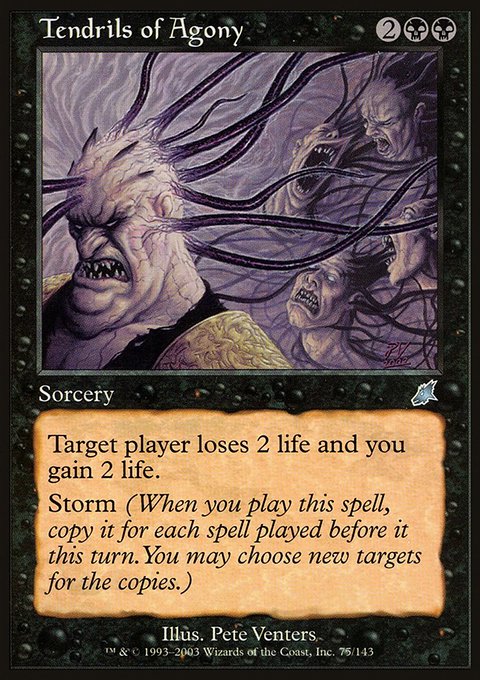
This already required 5 spells in hand to go off and was cumbersome but did add some additional business to the decks. Another cute tech people were trying was based on an old list called Dancing Ghoul. The aim of the deck was to cast Corpse Dance or Shallow grave on a Sutured Ghoul whilst having put 2 of either Phyrexian Dreadnoughts or Krosan Cloudscraper in the graveyard with Buried Alive. It was a spiritual predecessor to Tin Fins. Adding Doomsday gave the deck a method of finding all/the last pieces needed to go off over 2 turns if you needed all and 1 turn if you had a piece already. The entire thing could be powered out by a mix of Dark Ritual and Cabal Ritual.
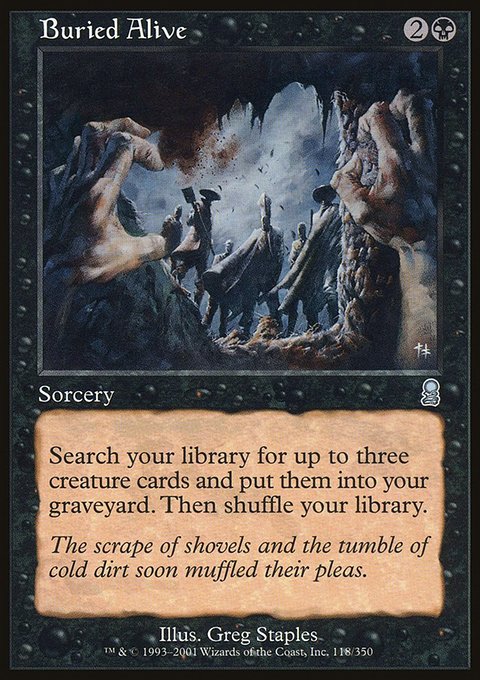
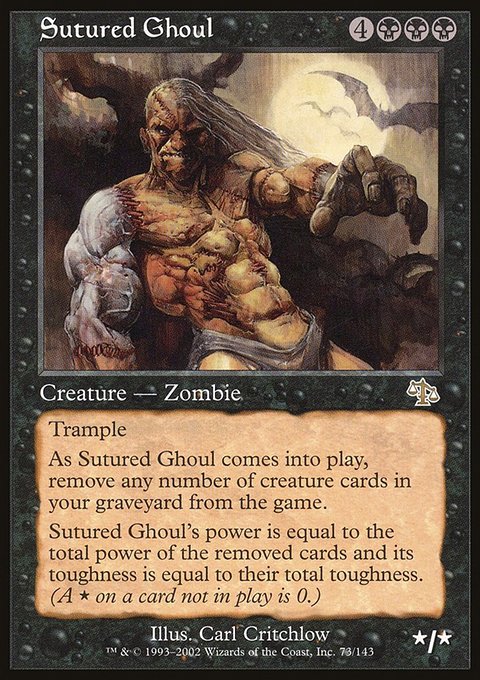
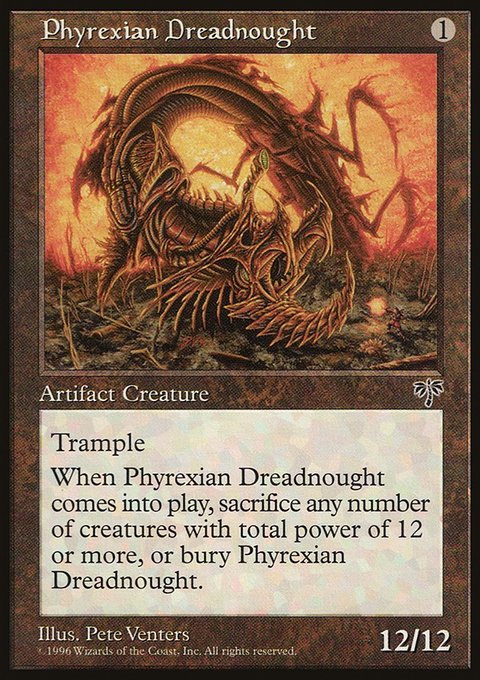
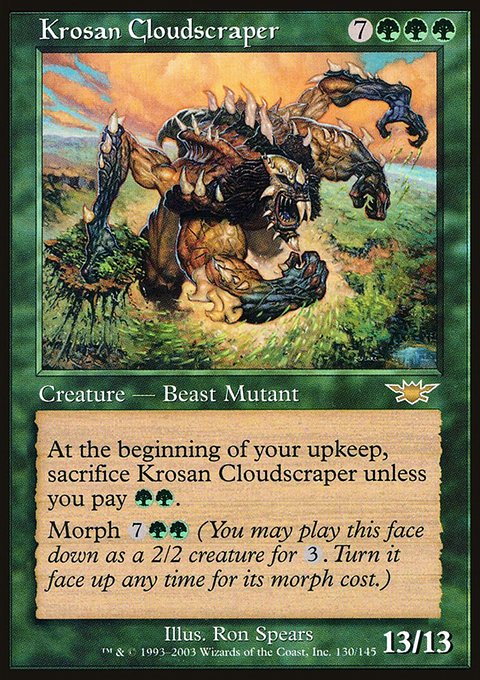
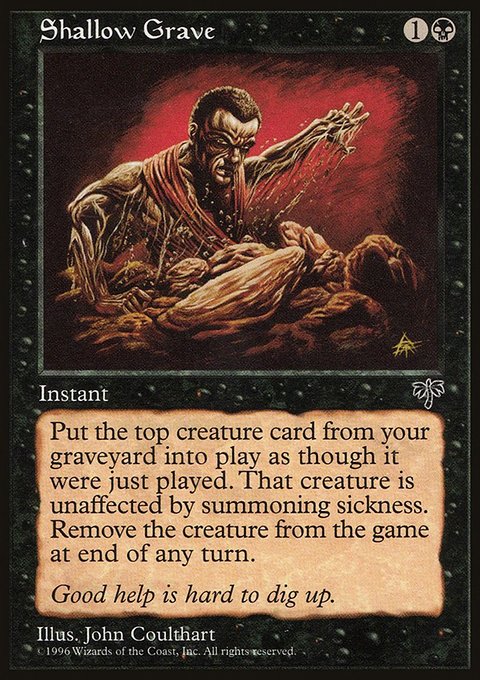
These lists were creative but generally not very effective at all and normally relied on Doomsday as a secondary plan to the main combo. At this time there was one version of the deck that did have a relatively clean pile being available making use of the, as then, new cards from Mirrodin block.
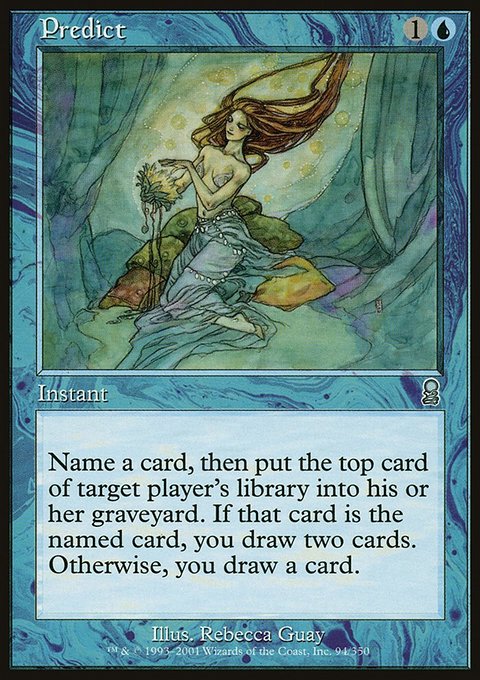
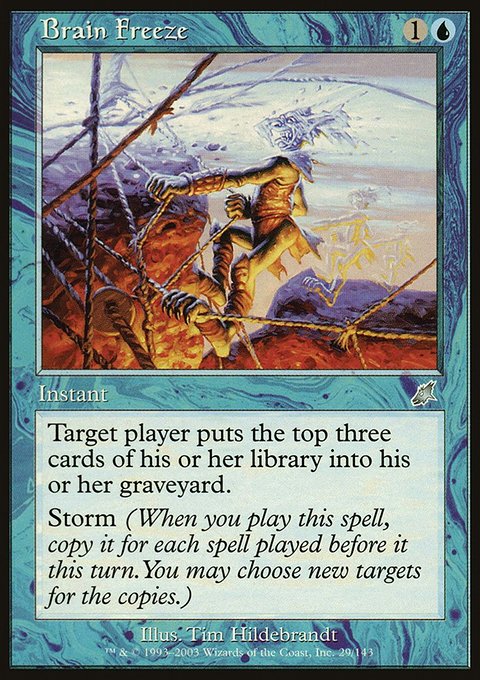

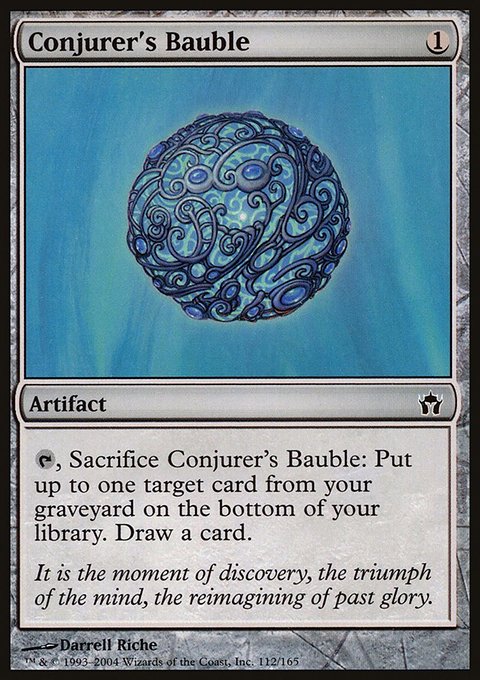
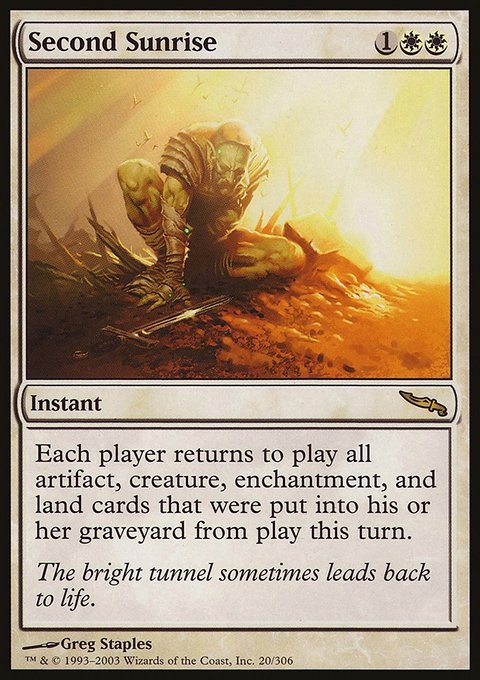
This cost a cantrip plus to enact on the same turn or you could also pass the turn with it. You cast Predict, naming Brain Freeze and drawing LED and Bauble. You cast both, crack LED for and activate Bauble, targeting nothing. Bauble will draw Second Sunrise which you cast, returning LED and Bauble to play. You then crack LED for again and activate Bauble targeting Second Sunrise which you will then draw. You repeat this loop until your storm count is high enough and finish by cracking LED for and targeting Brain Freeze. The pile is mana efficient however relied on the graveyard to be used which was dangerous as Tormod's Crypt was one of the most commonly played sideboard cards at the time. It also had some trouble finding the pieces as the only non-Brainstorm cantrips available were Serum Visions and thing like Portent however these weren't even really used. The main lists focussed on using Mystical Tutor and Lim-Dul's Vault to assemble the pieces they needed to go off.
When Champion's of Kamigawa came out in late 2004 it brought with it a new tool to the deck in the form of Sensei's Divining Top. With this being printed a new combo was identified that allowed pilots to avoid the use of the graveyard entirely. If you combine a pair of Divining Tops with Helm of Awakening, you can loop them to generate infinite storm as each Top now casts for . You can use these to generate storm and then spin the top at the end to draw into the lethal Brain Freeze. The pile in isolation can seem clunky however as multiple Tops and Helms were run, it is likely you would aready have cost reduction or digging already available.

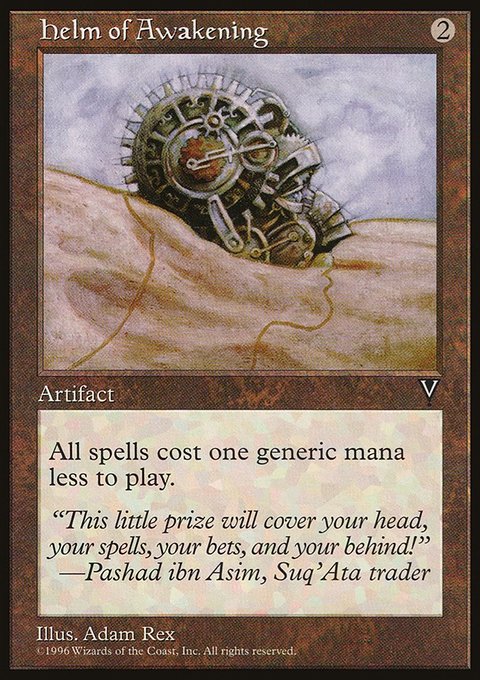
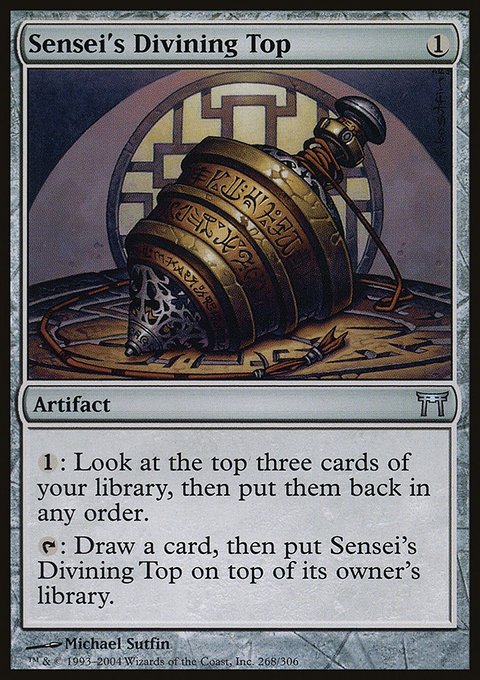


1 Top in play +





1 Helm in play +





This pile was resilient to graveyard interation however was still reliant on both activated abilities and artifact synergies which were hurt by Pithing Needle and Null Rod respectively which were relatively common from sideboards. The decks were certainly playable, but far from competitive at the time. It wasn't truly until a group of people working on completely different decks found the answer did the Legacy deck truly form.
The Start of Legacy - Early Storm Lists
Moving sideways for the time being, storm decks were viable from the onset of Legacy with the most well known list at the time being known as Iggy Pop, designed by Michael Bomholt whose original primer can be found here. Iggy was a storm list based around the engine of Ill-Gotten Gains coupled with rituals effects, other fast mana, Lion's Eye Diamonds and Tendrils of Agony with tools like Mystical Tutor and Intuition to find them. The deck was very proactive, to the point it didn't run much protection at all. Discard effects like Duress weren't viable as, due to the mirrored recursion effect of Ill-Gotten Gains, discarding disruption was pointless as the opponent could just return it to their hand during Ill-Gotten Gain's resolution. The mana base was also very clean so pilots did not tend to splash for cards like Orim's Chant and, because of the use of Lion's Eye Diamonds (LEDs), countermagic was not viable either. As a result it was very all-in as far as combo decks go. With the deck you could loop Ill-Gotten Gains and, with a Dark Ritual and an LED, you could net mana each loop. To close the loop you could Intuition for 3 copies of Tendrils of Agony to win. It was very consistent boasting 8 maindeck tutor effects and maindeck removal like Chain of Vapor or Cabal Pit.
It's here in our story where we re-focus on Emidln. Emidln had gotten a taste of competitive magic and so started browsing forums to find out more information. Places like the StarCityGames, The Mana Drain forums (in the new legacy section, The Mana Leak) and the MtGSalvation forums. He started to meet and become friends with people online, chatting via Aim, MSN, IRC, ICQ and a whole host of other messaging platforms. He realised he very much enjoyed the idea and style of the combo decks that were coming out and was invited to a specialised team forums for Team Blitzkrieg or BZK for short. On the BZK forums all manner of combo decks were being discussed including early Spanish Inquisition lists, the aforementioned Iggy Pop and some new decks that would start to evolve into more Modern storm lists and Emidln was in the middle of them.
Spanish Inquistion is a deck that a lot of people still hold very dear to their heart to this day. The idea of the deck is to utilise fast mana and ritual effects combined with draw 4's like Cruel Bargain and Infernal Contract. Land Grant, along with Culling the Weak and creatures like Phyrexian Walker were used to cheat on mana and then the deck finished off opponents with either Tendrils of Agony or Goblin Charbelcher. There was a point in time where the SI decks tried a number of cards in them to increase the business count available as the draw 4's could be unreliable. Cards like Diabolic Intent worked alongside the tallmen approach with Shield Sphere and friends however this did stretch reliance on the creature aspect. Doomsday was explored by Emidln and BZK friends; B.C., Evenpence and Desolutionist as a way to incorporate additional business into the shell to some success but the deck, although fast, did not achieve any top tier status.
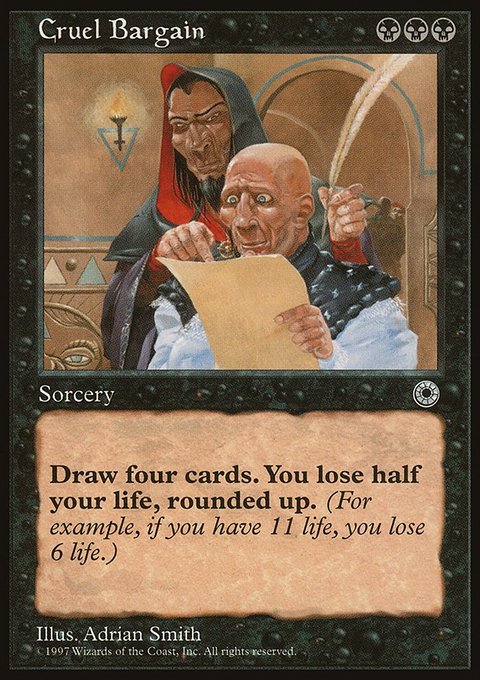
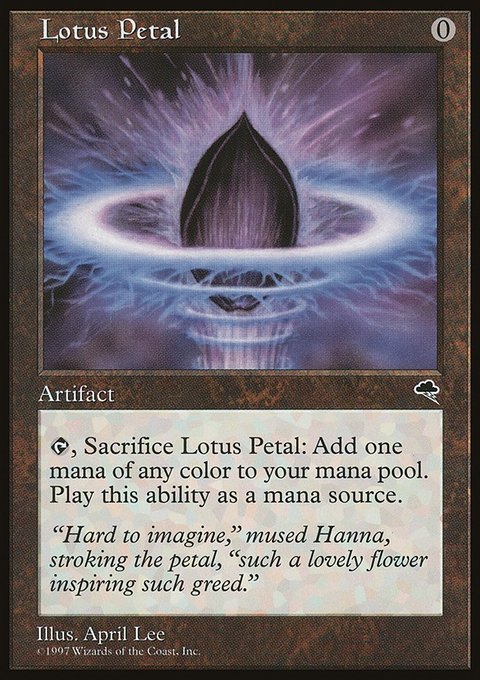



In 2006 Iggy pop got a large boost in the form of Leyline of the Void from Guildpact which allowed it to mitigate the balanced nature of Ill-Gotten Gains by removing the opposing hand from the game entirely. It could also just be used to make an opponent go hellbent from turn 1. Another very key card was printed in Dissension in the form of Infernal Tutor. This card allowed for a combo with Lion's Eye Diamond to achiveve hellbent status and effectively become a Demonic Tutor in doing so. It also gave more power to other branch decks like Nausea which ran Spoils of the Vault, Chromatic Sphere and Helm of Awakening as an engine. The deck actually ran a single copy of Doomsday as a wish target with Meditate being the draw 4 of choice.
Legacy Evolves, Storm Starts to Diverge
2006 was a pretty crucial year for storm with the introduction of the set Time Spiral. This was the first set since Scourge to revisit the Storm mechanic providing two key cards: Grapeshot and, more importantly, Empty the Warrens. These cards gave a huge boost to the decks trying to use them with the Goblins plan allowing players to go off much earlier with a quick Empty for 5 or so presenting 10+ power on the board from turn 1. This also gave a huge boost vs the Control decks of the time which didn't have mana efficient board sweepers to deal with such aggression. Two key builds of storm quickly appeared to make use of them. The first was designed by user Wastedlife (now better known as a certain Bryant Cook) who came up with this deck concept known as The EPIC Storm, or TES for short. This started utilising principles such as including main deck protection and a diverse tool suite to try and run hard and fast.
From a Discord log from Emidln:
TES actually began as a way for Bryant to abuse Culling the Weak it played Priest of Gix and Trinket Mage for LED/Petal as extra value on Culling the Weak
He kept iterating on the deck and I kept trying to play it, because I loved storm we both recognized very fast that Empty the Warrens was going to change storm to good effect
I think by GP Flash, we had finally cut Plunge into Darkness from TES
When Coldsnap was released it brought with it Rite of Flame which allowed the ditching of the less efficient creature plan and combine them alongside the traditional ritual effects to speed up its mana even faster. Because of the colour requirements involved with running rituals and discard effects alongside rituals and Burning Wish with Chant effects as additional protection, tutors and filtering and even tools from the sideboard it had to run a full 5 colour manabase. City of Brass and Gemstone Mine were the deck's lands of choice alongside Forbidden Orchard to power out it's aggressive threats.
At the same time as Wastedlife developed TES, Emidln was working on a deck called Fetchland Tendrils (FT) at the time moving into 2007. Whereas TES was a 5 colour monstrosity built for speed, FT was focussed on the traditional shell of fetchlands and duals to run a manabase. It also ran the same tutor packages with Mystical Tutor but also ran Grim Tutors. These were very highly priced at the time being only printed in a small Starter set. Mtgthesource was now active and the very first response to Emidln's initial post on the Fetchland Tendrils thread is from user APriestofGix who says:
You deck could be as good as Hulk Flash, and never see play because of the price tag.
2006 also introduced Infernal Tutor from Dissension. This was a card that could act as both a way to double up on ritual effects in hand whilst also having the potential to act like a full on Demonic Tutor when coupled with LED. This card would help power up TES as it grew along with other fledging storm variants at the time. In Iggy Pop it began to replace Intuition. Being more resource efficient in terms of mana, not requiring mana so was castable purely from ritual effects and being fine in multiples gave Infernal a number of advantages over Intuition. Finally, Infernal Tutor allowed decks to run fewer copies of Ill-Gotten Gains. Although the card was good, drawing multiples of it was very bad. Tutor meant that you only needed to find 1-2 Ill-Gotten Gains to be able to fully combo off as you could use the tutors to find a missing piece or chain them into the Tendrils.
2007 had given the format a number of key staples still used today. Ponder, Thoughtseize and Street Wraith all entered the scene and immediately were given a home in the early FT builds. Lim-Dul's Vault could now be cut for a superior cantrip suite and more maindeck disruption in discard and chants could be added. The reliance on Ill-Gotten Gains was reduced as drawing multiple instances was very bad for the deck. Some of the learning from SI was also ported over using the draw 4 effects to provide extra business and grinding potential. Empty the Warrens was added into the deck for additional speed and the deck also boasted maindeck permanent hate in the form of Chain of Vapor or newly printed Wipe Away. Given that Counterbalance and Top were now in the meta together, this was a key tool in the storm player's arsenal. The deck also ran the full 4 Sensei's Tops as these functioned as additional card filtering, long game advantage and often as an 8th card in hand during your combo turn or as a way to gain extra draws using a trick with Top and Chain of Vapor to bounce it in response to the trigger.
The deck was very open to intepretation and, in Emidln's own words:
This archetype is extremely customizable. The basic requirements are blue/black fetchlands, brainstorm, dark ritual, lion's eye diamond, and tendrils of agony. Everything else is basically up in the air.
— Emidln
Overall the decks were starting to become a lot more streamlined. With the onset of better cantrips, exploration of correct cantripping and fetching mechanics were starting to be explored. What are now assumed basic mechanics for a lot of Legacy decks were almost unheard of back then as the format, and the skills involved, were still fledging. This is also where we start to see the birth of more modern storm variants with the Xerox concepts of cantrips over lands really taking effect. 4 Brainstorm, 4 Top, 4 Ponder and 4 Street Wraith became a staple build with Wraith allowing you to grab any card fetched from Mystical Tutor in the same turn as a build your own Demonic Tutor type affair.
It was also around this time that Emidln and Wastedlife set up the Stormboards. BZK was a team affiliated site with other people who worked on seperate teams not wanting to share testing results or tech. Because of this, Emidln wanted to set up a non-team affiliated space where people who loved all sorts of Storm combo could discuss things freely. Here he was later joined by other active users including prominent French player Lejay.
Within this new forum, and with other online spaces becoming more active, players were able to really develop the fundamentals of Legacy Storm. It is also around this era that we see start to revisit an old friend and give it a new feel.
Doomsday Meet Tendrils. Legacy Meet DDFT
It was was online user Breathweapon who first suggested taking the Doomsday shells that were floating around and try incorporating the traditional storm kill into it. As mentioned with the Nausea deck above, Doomsday was a potential tool that people could run already in storm as a non-graveyard dependant engine away from ill-Gotten Gains but it was still never the main focus of the decks. Breathweapon suggested a few Storm based piles, most very simplistic variants such as:
Cantrip +
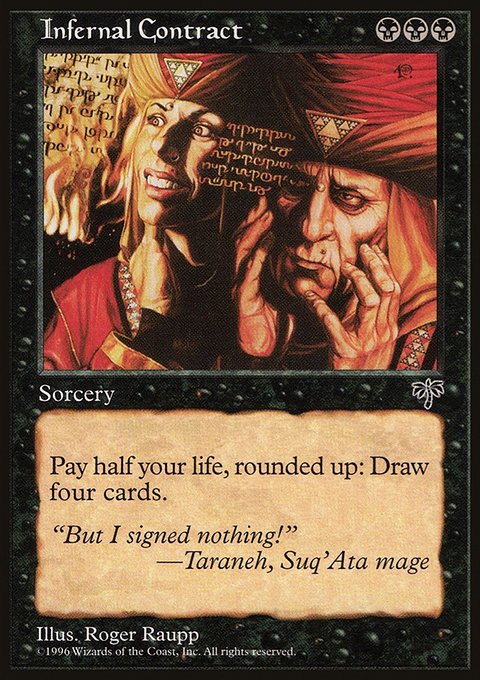




On seeing this Emidln sat down online with goobafish (inventor of Canadian Threshold), desolutionist, rsaunders, Whit3_Ghost and birdman along with many other fellow BZK members to map out and test potential kills that could come from this Storm x Doomsday deck idea as part of a large collaborative effort. Doomsday followed a lot of the mana principles of Fetchland Tendrils and could run tutorable toolbox into the Doomsday piles. This period of time from 2007 through into 2008 was when Doomsday was really developed as a deck. People were discussing a lot of spicy inclusions as part of the learning / brewing process.
From an Emidln mtgthesource post in 2008:
I'm going to go ahead and decree the following:
4 Sensei's Divining Top 1 Doomsday 1 Death Wish 2 Tendrils of Agony 1 Ill-Gotten Gains are MANDATORY in Fetchland Tendrils.— Emidln
Brainstorm in hand + 2 cards in hand +


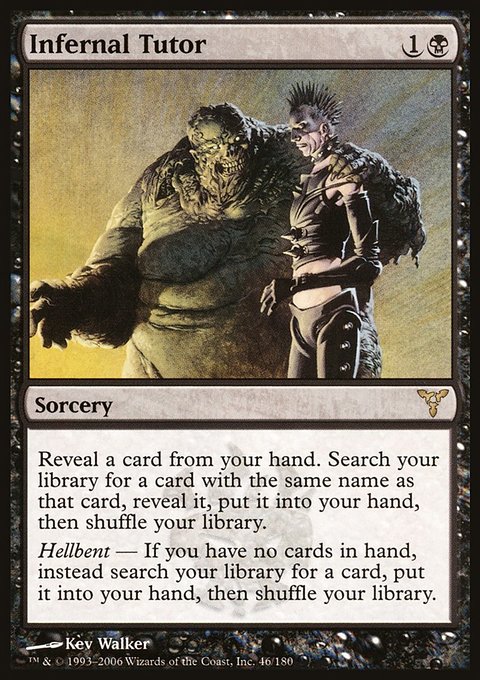
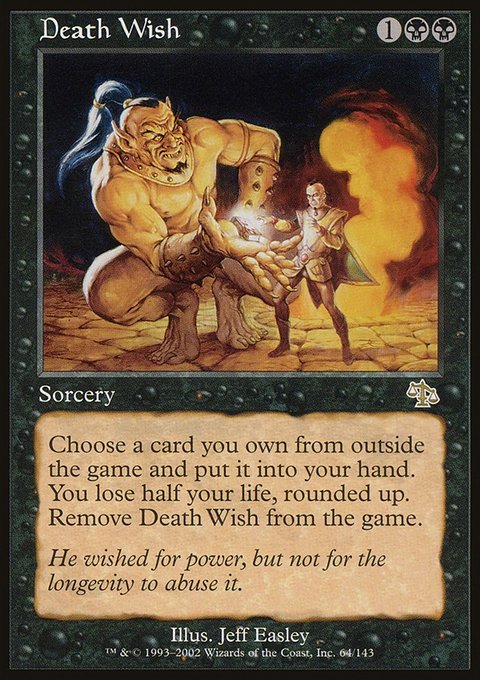

A lot of what is taken for granted in modern lists wasn't considered back then. Ideas Unbound existed but wasn't considered instead having people favour draw 4s like Meditate.
From Emidln chatting to me on Discord:
Our tech was pretty bad though
IU existed, we just didn't use it we also didn't really realize that the pattern matched "piles" for Brainstorm/SdT
Could work without IGG for a while
As is said in our recording:
We were slow to change.
Late 2008 saw another key Storm card enter the scene from the Alara block; Ad Nauseum. The Storm decks had already been diverging over manabase but this really tipped things over the edge. We'd already seen Iggy Pop split into FT and TES. We now had further splitting into TES, FT, Next Level Storm NLS and Doomsday Fetchland Tendrils DDFT which finally became its own thing. Ad Nauseum pretty much completely replaces Ill-Gotten Gains as the primary combo engine easing up on the graveyard aspect and thus leaving Iggy Pop as an archetype in the dust. TES adds in Simian Spirit Guides and 3-4 Ad Nauseum, the rest add between 1 and 3. Questions start getting asked about things like having Burning Wish vs not, the desired speed of the deck and the relevancy of chant effects vs discard.
From Dark_Cynic87 on the mtgthesource Fetchland Tendrils thread:
Well, considering the options, you can go one of two routes with FT:
1. D-Day, a more controll-ish build that is slower but more resilient to discard, counterspells, and other disruption such as Mages and Teegs, CB (to a point), and Chalice,
Or
2. Balls-to-the-Wall. Doesn't need resiliency to disruption as it expects to only see 1x FoW/Daze, one Duress/Seize/Hymn, or maybe a chant or Teeg/Mage.
There is no happy medium. There probably never will be.
It is the concept above that causes FT/NLS to further develop into what becomes known as Ad Nauseum Tendrils or ANT. TES also starts to pick up the concepts of using a fetchland manabase, deviating away from the full 5 colour package. As 2009 comes around Lejay leads people in starting to work on using Ideas Unbound as the primary pile draw engine of choice over/alongside draw 4s. Although TES was fast, and becoming one of the more popular Storm lists, it had a lack of maindeck permanent removal and one of the most popular decks of the time ran multiple copies of Gaddock Teeg. Maverick as a deck was very popular and the legendary hatebear could stop Tendrils and Empty all by itself. TES at the time was not running removal and previous Iggy style decks had picked up Repeal as the main tool of choice which could not be used against it. The Doomsday deck could run Chain of Vapor and incorporate it into piles almost for free as it could be used on your own Top or Petal to generate storm or draw an extra card whilst then bouncing an opposing Teeg.
CoV in hand + SdT in play +




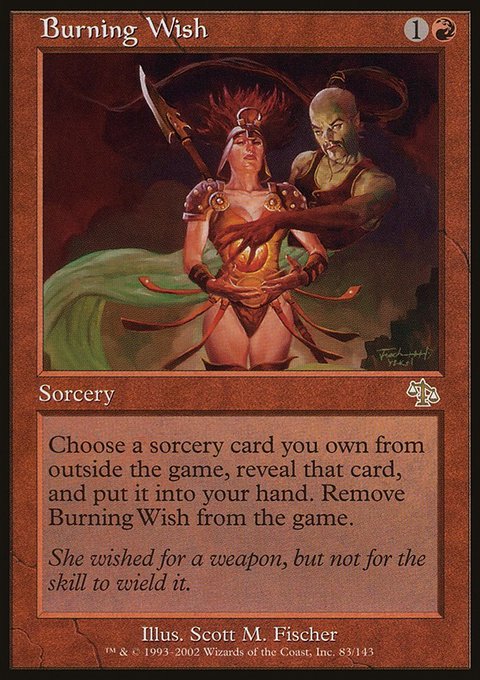
1 SdT in play +


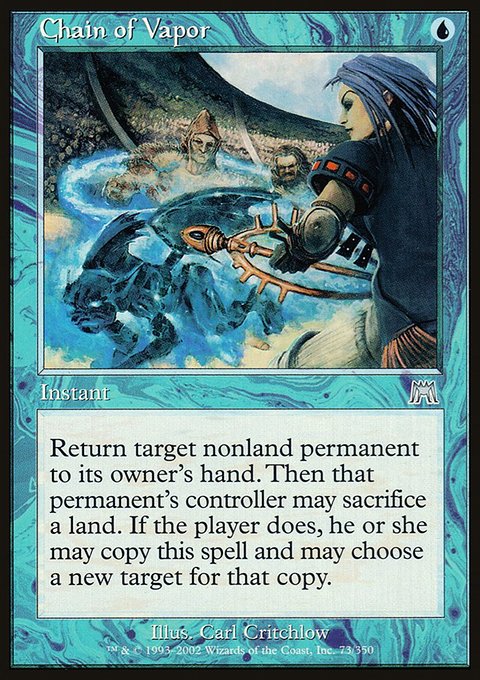


NLS was like a Doomsday / FT / Ad Nauseum hybrid that had access to both the fast kill that TES ran, albeit a tad slower, and the anti-Teeg/more versatile or grindy style that Doomsday had. Users like Cheeseburger and Nemavera put a lot into what was listed as a German Variant of NLS. It ran so many tutors/wishes that it was very consistent in picking up the pieces it needed for any given scenarios and had a huge toolbox of options. As 2009 drew to a close there was a much greater understanding of the fundamentals that modern Storm decks needed a large movement to start trimming the fat out of decks. There was still no general consensus on a best list for Doomsday decks. Emidln makes mention of user piZZero in helping understand some key points on play and how important it is to truly understand ones own decklist.
2009 also brought with it the printing of Silence, Leyline of Sanctity and the enemy coloured fetchland cycle such as Misty Rainforest. Prior to this, Storm had been mostly limited to using Polluted Delta, Flooded Strand and Bloodstained Mire as its land suite of choice favouring Esper configurations however this new set of fetchlands opened up more possibilities for splashing into or whilst still being based in . Along with these new cards, September saw the unbanning of a couple of key cards including Entomb. Entomb allowed reanimator strategies to flourish seeing them effectively become efficient tempo decks that could make use of Force of Will and Daze putting threats like Inkwell Leviathan, Blazing Archon and Iona, Shield of Emeria into play. Because of the appearance of this alongside the NLS decks, TES, what was now becoming ANT and the recently unbanned Dream Halls x Show and Tell deck the format became very combo oriented.
Goodbye Mystical Tutor, Hello Preordain
In June of 2010 Mystical Tutor was banned in Legacy. The reasoning was due to the highly successful and domineering presence of Reanimator and other combo decks that utilised the card very well. As a result a number of changes occurred within the Doomsday lists of the time. A mere month later the card Preordain was printed in M11 and it eventually was to transition over. Because of the previous reliance on Mystical Tutor to find the title card Doosmday itself, more pilots started to adopt Burning Wish into their lists as Doomsday copies 4-7. Ideas Unbound finally gained a wider acceptance in lists with pushing from Lejay and cheeseburger, first as a Wish target and then more into the main deck. Street Wraith had already started to be dropped due to disynergy with Ad Nauseum and lost its home completely in the deck. Many people still stuck to using Lim-Dul's Vault as a pseudo tutor within the deck or trying to work with Infernal Tutor. It took quite a surprisingly long time for people to finally adopt the leaner way of deck construction. This is of course easy to say with hindsight but it may not have been obvious at the time. Once again there was huge variance in pilots lists with some people trying out Personal Tutor and Daze, many still had either a single main deck or wishable Ill-Gotten Gains. There was also a divide still on whether to run 7 discard effects main, 7 chant effects main or a split of the 2. Cabal Ritual slowly started to be dropped too as the deck moved away from Ad Nauseum and instead opted to use Rain of Filth as the goto ritual #5. There was a big reason that lists began to move away from Ad Nauseum in Doomsday whilst ANT and TES stuck with it and that was because of one very large printing that ocurred: Emrakul, the Aeons Torn.
People very quickly picked up the combo of Emrakul along with a relatively innocuous land from Lorwyn, Shelldock Isle. Isle is the Hideaway land whose trigger is for a library to have 20 or less cards in it. Thankfully a player resolving Doomsday meets that requirement perfectly. If you activate Isle with an Emrakul hidden under it you count as casting the card thus netting the extra turn trigger and gaining an uncounterable 15/15 with flying and Annihilator 6 for the cost of . This slotted into Doomsday easily, initially with people testing in maindeck. Ad Nauseum had to be dropped because having a 15 cmc card in your deck could prove pretty lethal otherwise. The combo gave a big tool to DDFT which it had been missing for awhile in the form of a pass-the-turn pile plan that circumnavigated countermagic. Pretty much every DDFT, and ANT deck for that matter, adopted the Doomsday into Shelldock plan as part of their sideboard.





People also worked out ways that could be used to ensure you could resolve it in the same turn you cast Doomsday using Cloud of Faeries as another enabler.
Land drop available + Cantrip + 1 card in hand +


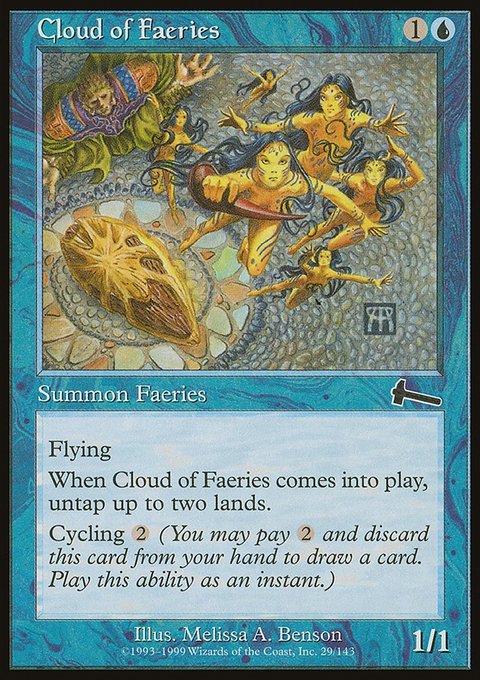


This technology was adopted by other storm decks to form an easy sideboard strategy that could be used to beat control decks as, once Doomsday had resolved, the combo was hard to interact with outside of Wasteland. The card also incidentally gave the deck resistance against Painter's Servant x Grindstone decks of the time.
Lejay had some additional fun coming up with some silly, if inefficient, tech involving multiple Ideas Unbounds and Emrakul to enable shuffle.
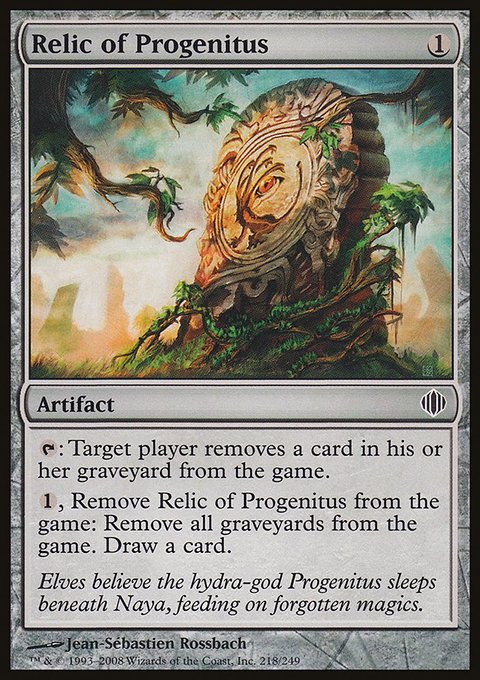




Lejay from a Stormboards post in 2010:
The Unbound Emrakul piles:
These 2 piles require a second Ideas Unbound either in the main or sb (or both main) and a SdT in play.
Relic of Progenitus, IU, (or BW + ), LED, Emrakul, IU (or BW + )
Pile A, pass the turn
Mana: . You need no card in hand or a LED to discard.Pile B, with cantrip
Mana: . You need a Brainstorm/Ponder in hand and no other card or a LED to discard.For both piles: draw and play relic. Activate it (last window to discard your hand with LED) removing graveyards and cantripping into Ideas unbound. Play Ideas Unbound to draw Emrakul, LED and Ideas unbound with no cards in library. Play LED. Play ideas unbound and in response sacrifice LED to discard Emrakul and shuffle your graveyard into your library. Ideas Unbound resolves giving you Emrakul, LED and Ideas Unbound with +1 mana. You have a loop. When you have enough mana you can just play LED and crack it to shuffle the four cards in your library. Then activate Top. If Emrakul is in top three you just have to draw it and hardcast it. Otherwise draw an Ideas Unbound and play it. Play the Top and tap it to get Emrakul. So 3/4 of the time you are completely safe, and 1/4 of the time this pile will need the opponent to be at 15 life or less.
— Lejay
Rev 614
Alongside the normal DDFT variants another style of Doomsday list started to become popular. Show and Tell based decks were already a known entity in Legacy and the printing of Emrakul had given them a much larger and more difficult threat to deal with than many that preceded them pretty much only being beaten by Edict effects, Oblivion Ring and Karakas. Emidln first posted the idea in April 2010 of combining the Show and Tell style list with that of a DDFT style list. The deck was titled Rev 614 after the following passage from the bible, Book of Revelations, Chapter 6, Verse 14:
The sky was split apart like a scroll being rolled up, and every mountain and island were moved from their places.
This was a reference to the Annihilator 6 trigger of Emrakul causing the destruction of lands which includes of course, Islands and Mountains.
The first version of the deck retained the Tendrils based storm kill as an option and, being pre-Mystical ban, used a full set of Mystical Tutor with Lim-Dul's Vaults alongside an Intuition to find all the pieces. It allowed you to either Show and Tell into Emrakul, Doomsday into Tendrils or Doomsday into Shelldock Isle all in the main deck. The deck survived the Mystical Tutor ban and gained quite some popularity moving away from the Tendrils build to an all-in Emrakul build. It played very much like a combo-control deck running Force of Will, Top and other lighter permission. The most notable result it had was with a version dubbed Ugly Duckling run by Chris Gosselin. This version ran Spell Pierces, Thoughtseizes, Stifle and a number of spicy sideboard inclusions like Form of the Dragon and Armageddon (for flavour reasons maybe?). He made top 8 of GP Columbus in August 2010. You can find a video of the full deck tech here. Outside of 2010-2011 the deck didn't see a huge amount of play however as it could be awkward and have some slightly dodgy starting hands with Doomsday + Emrakul not always aligning fully.
The deck excelled against oppsoing combo and control due to the high amount of disruption it ran and the resiliency of the threat base however it was poor against oppsoing aggro like Zoo. They could pressure the life total with Bolts if Doomsday was ever cast and had Karakas for any attempts to use Emrakul. The deck eventually fell out of favour due to some very big format changes that occurred within 2011.
The Golden Age of DDFT
The first major changes in 2011 revolved around the printing of the complete Scars of Mirrodin block. The introduction of cards like Batterskull coupled well with Stoneforge Mystic giving further popularity to Stoneblade style decks and Death and Taxes alike. The main change from the block though was the introduction of the Phyrexian Mana mechanic. Mental Misstep, Surgical Extraction and Gitaxian Probe were all printed in New Phyrexia and made big ripples in the format. Misstep was adopted by many decks if for no better reason than to combat opposing Missteps. Surgical started to replace the previously popular Extirpate as a more mana efficient graveyard hate tool in many decks. DDFT didn't need to run Misstep at the time. It ran a lot of 1 mana spells but still had reliance on LED for most of its wins. It also provided a natural home for Gitaxian Probe which allowed the dropping of any remaining usage of Street Wraith along with obsoleting the need for Preordain or Lim-Dul's Vault. The ability to win on turn 1 or 2 was made much easier thanks to both the +1 storm factor, the free draw spell and the early information that could be obtained.
It was at this point that DDFT really started to take on the form that would remain mostly unchanged until 2014. It would be in the main with as a routine splash colour from the side. 3 Doomsday main with 4 Burning Wish to find the 4th copy in the side. It would run 12 cantrips (Ponder, Brainstorm, Probe) alongside 4 Tops for filtering. Protection was in the form of 7-8 discard or chant effects main with additional discard that was wishable. This was normally in the form of 4 Cabal Therapy and 3-4 Duress (Silence if in ) with maybe a wishable Duress or Thoughtseize. The combination of Probe and Therapy was very effective against a lot of the format. Normally 5 ritual effects were run comprised of 4 Dark Ritual and 1 Rain of Filth. The combo package was basically 1 Ideas Unbound main and 1 Tendrils that could be wished for. Other tools like Empty the Warrens, Lotus Petal, wishable draw 4s were all avbailble for customisation and could be added or removed as needed. The wish board gave a large toolbox that helped deal with many problem cards that other storm variants could struggle with in game 1 and the deck could both play a long grindy control game and eventually go over the top with Tendrils or just get a turn 1 kill out of nowhere.
This is where the majority of the common piles were developed if they hadn't been used before.
Cantrip +


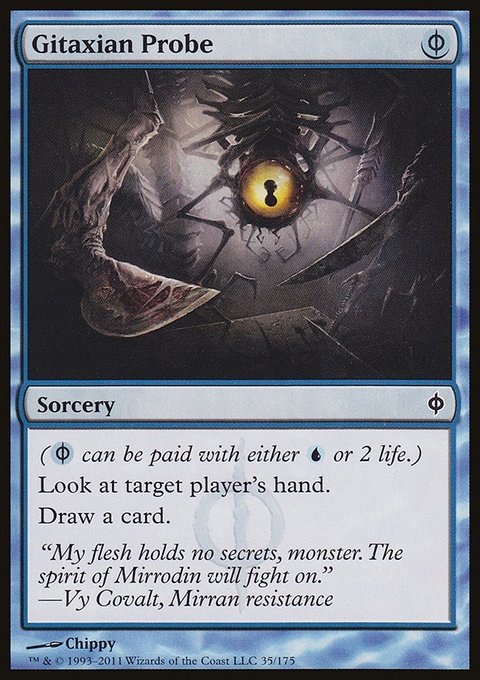


2 Cantrips +





Cantrip + Top in play





Pass the turn +





Burning Wish (Wish for Ideas Unbound) + Cantrip





DDFT saw high popularity and was well placed against a lot of the meta. As a result it put up good results between the printing and after Misstep was banned in September 2011, it was likely one of the better decks of the format. This Golden Age as Emidln proclaimed it did not last long however due to the onset of a new block, a new set and the printing of another key set of cards. This block is so influential on the format that people have even been trying to push fan formats around ommitting it entirely. Enter Innistrad block.
Innistrad - The Start of the Decline of DDFT
We touched on how throughout the last few years prior to 2011 there had been innovations in the concepts of efficiency. Decks were slowly learning to cut cute cards or corner case elements and replace them with leaner versions. This had been slowly happening in an organic fashion until Innistrad was printed and veritably cranked this process up to 11. The set saw the printing of 3 key cards for DDFT in particular. The first was a positive addition, the second a rival and the third a threat.
The first key printing was Laboratory Maniac or Labman for short. Labman found a home in Doomsday whereby he could easily slot into a lot of the key piles that were already designed for Tendrils and provide an easy pass-the-turn alternative where needed. He also used less space than Emrakul+Shelldock Isle, requiring on a single card slot instead of 2, and did not have a weakness to Wasteland or Pithing Needle effects. He was partially vulnerable to removal however it could be set up so that an opponent required multiple removal spells to beat him or, with the clever use of Chromatic Sphere he could be immune to removal completely.
Cantrip +




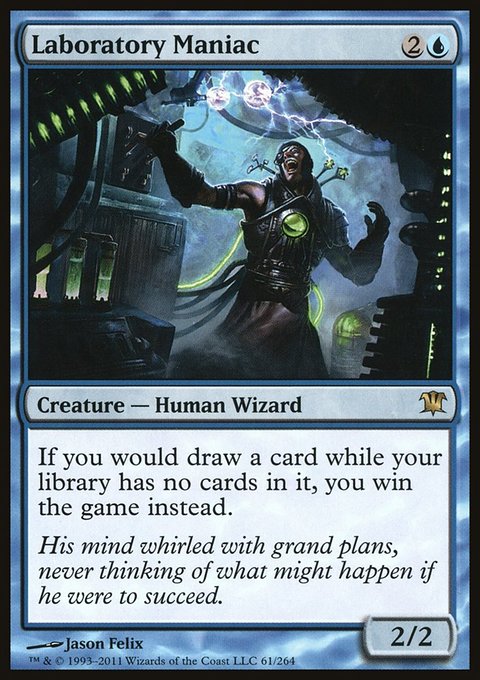
Cantrip + Top in play





Pass the turn +



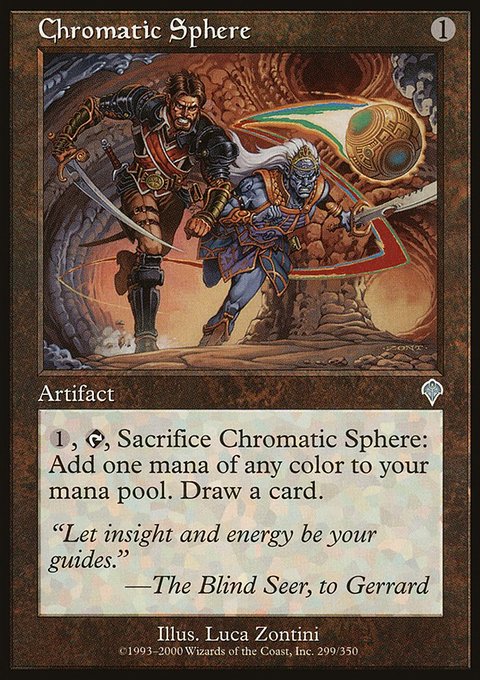

The piles normally worked by getting Labman and Top into play together and then activating Top to win. If you suspected removal you could pass until your next draw step forcing an opponent to try and make a move in which case you activate Top in response. If you have Sphere out when Labman resolves and a mana to activate it your opponent cannot respond. As the draw clause is tacked onto a mana ability they cannot respond with removal to the draw occurring. Pretty neat!
The second key printing was Past In Flames or PiF. PiF was the boon that other storm decks needed and was snapped up immediately by both ANT and TES. Unlike the previous recursion reliance on Ill-Gotten Gains, PiF enabled an assymetrical recursion effect that did not tax the life total like Ad Nauseum did. As a result it powered up the other storm decks no end. Unfortunately this had a negative impact on DDFT's perceived viability. Whereas before PiF there had been a number of strong arguments to run DDFT over ANT or TES due to the lack of reliance on Ad Nauseum, now that argument was forfeit. This card single handedly allowed ANT and TES to be top tier decks all through until 2020. It was of course discussed as to whether PiF could be utitlised by DDFT too with people exploring it as a Burning Wish target however it just did not fit in well with the rest of the deck and, with Doomsday itself removing your graveyard on resolution, it could not be incorporated into the shell.
The final key printing is of course Delver of Secrets. Prior to Delver the premier aggro threat of the format was Wild Nacatl. This was a non-evasive threat that required aggressive fetching of dual lands to enable it to achieve its full size. It tended to be run in Zoo, a deck that was low on disruption elements. Alongside this there was a tempo deck in the form of Thrash (or Canadian Threshold). This ran disruption and low to the ground threats like Tarmogoyf and Nimble Mongoose but didn't really have any truly aggressive turn 1 threats to play. It also could not incorporate Nacatl into the deck due to the pressures of the mostly mana base to fit with Daze and the cantrip suite. Delver changed all this entirely.
Suddenly the format found the premier aggro threat cost and had evasion. It fit perfectly into the existing tempo shells and enabled a quick clock backed up by disruption. Nacatl was made obsolete very quickly as the Zoo decks could not bring enough to the table in a purely aggro strategy. Delver also enabled the deck to become leaner and, because of how efficient it was at disrupting other decks in terms of manabase denial and stack based control, the rest of the format had to evolve to be able to try and fight it. From this point on the format would be dominated in some form by a Delver shell. The Innistrad block continued to deliver however providing cards like Thalia, Guardian of Thraben and Terminus into the fray. These gave decks like Death and Taxes and, what was just known as Counter-Top control to then become Miracles, new toys that boosted the efficiency of the format. Many decks that couldn't keep up with this new format had to be left by the wayside as a result. Most of the printings did not effect DDFT too much other than Delver but Delver proved to be a lot. Combo was always weak to aggro-tempo and trying to face a mix of quick and early clock backed up by Wasteland, Force of Will, Daze, Stifle, Bolt and Flusterstorm was very difficult for the combo decks to beat, Doomsday being no exception. 2011 would see the start of a decline in the number of pilots and results as more players took up ANT and TES and the meta became more hateful against DDFT. Countertop Miracles was quite difficult to beat without running cards like Krosan Grip. Piles being a mix of 0, 1 and 2 drops meant that often Counterbalance could disrupt you.
Along with this evolution of other storm based combo decks, control and tempo. Show and Tell and Reanimator decks get a boost from the printing of Griselbrand in Avacyn Restored. Grizzy-B immediately becomes the most efficient creature to cheat into play giving additional power to the existing Reanimator decks of the time and enabling Sneak and Show decks to flourish further as well. All these power ups across the rest of the format gave the DDFT lists a solid run for their money. Despite this seemingly bad time to be playing the deck, people are still well invested it making it work. A forum post from nanda sums it up nicely:
Okay, so the meta right now seems pretty bad for DDFT. But I've spent six months getting the cards for this deck, so I do not give a fuck – I'm playing Doomsday.
— Nanda
Meandeck Doomsday - Take 1
As 2012 rolled around the DDFT lists didn't change all that much other than the addition of Abrupt Decay to the deck. Decay gave a way for the deck to effectively beat things like Counterbalance and Chalice of the Void. The main thing that caused a stir was the conceptulisation if a novel style of Doomsday list, at least for Legacy, from Vintage Doomsday afficienado Steven Menendian of Team Meandeck. Menendian had been playing Doomsday with a control shell and Labman to great effect in Vintage and had an idea to port the list to Legacy. He released a purchasable primer alongside the deck on eternal central with a large array of puzzle situations to solve with it. The deck took the Vintage concepts of being a combo-control list running an unprecendented amount of reactive disruption for the archetype. Force of Will, Spell Pierce, Pact of Negation, Misdirection and Divert were all featured over traditional elements like discard. An Ideas Unbound effect was removed entirely along with the LEDs to enable this suite of counterspells. The deck ran 6 ritual effects supplemental Dark Ritual with a pair of Cabal Rituals. It still retained the 4 Tops and 12 other cantrips and ran a purely UB manabase boasting 5 basic lands. The only win condition was a single Labman main with no Burning Wishes in the list. The pile package comprised of 2 additional cards; Mental Note and Unearth. The primary pile it ran went as such:
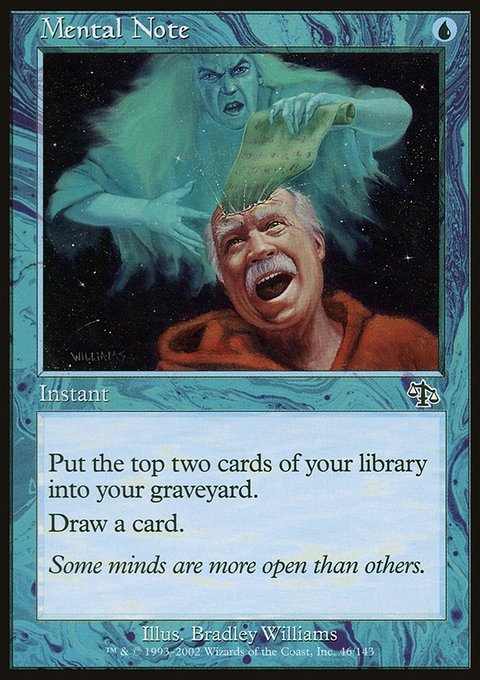

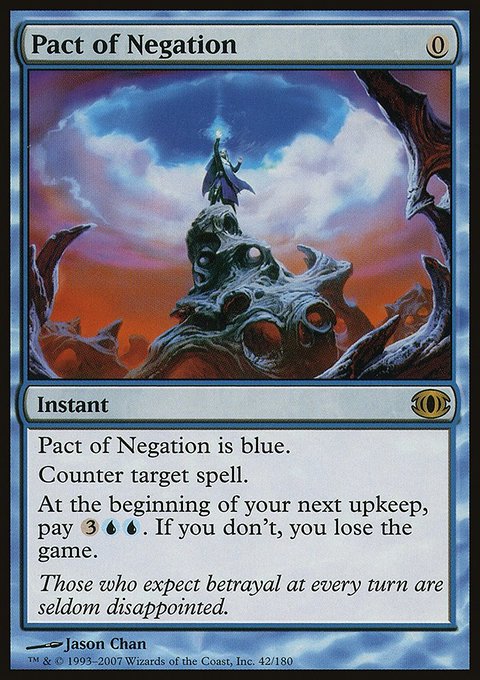

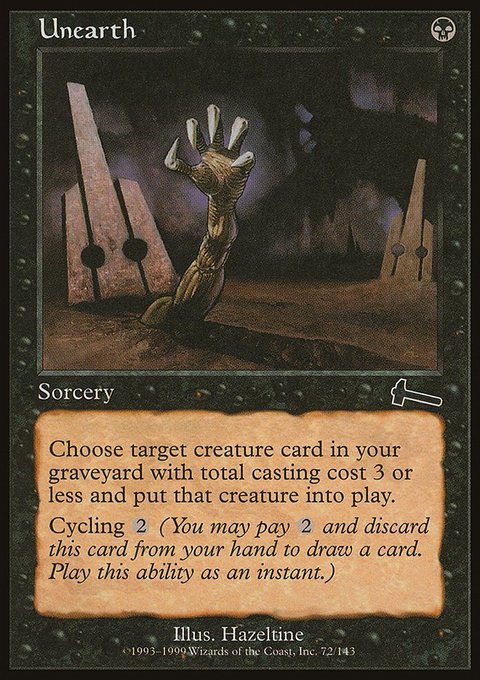
The idea was to play a heavy control game, utilising the reactive elements and getting Top online. Once Doomsday is assembled you cast it and, either try to win on the spot, or pass the turn and defend using your control elements to the draw into the pile. As the pile doesn't use LED it means you can hold up your reactive spells whilst enacting it. It also seems very mana efficient requiring only to enact (sans a draw effect). Menendian heralded it as the next big thing in legacy citing:
If your mind isn't blown, then you are probably a little bit confused or perhaps even skeptical. That's because no one in Legacy has seen a dedicated list like this before. Much like when European explorers beached on North America or when NASA astronauts landed on the moon: you are seeing something totally different from all that has come before. I will explain all in this article.
This was a pretty big claim to make given that the current DDFT deck was still very much alive and healthy enough at the time. It was met with mixed reviews, many liking the concept of the deck however an equal number critiscizing the apparent increased fragility it presented. Menendian had this to say on the mtgthesource thread on the article:
The main advantage of Doomsday over other Legacy combo decks – whether they be Show and Tell variants or what not – is that it is a one card combo to initiate the combo process: all you have to do is resolve Doomsday. Show and Tell decks require you to put other cards in hand. Same with High Tide. Because of that advantage, Dday decks can be much more streamlined and efficient, and can have alot more counter-protection.
That's why I believe Dday can be not only the top Combo deck in the format, but one of the best decks in the format period. This Dday deck has almost none of the weaknesses of the Tendrils Dday decks, while being much easier to play, but exposes itself, very slightly, to other forms of hate. I've built this deck to mitigate those.
— Smmenen
Now the point above is bang on the nail so to speak. Time and new printings, which we will get to later, have proven that the theory of it being a 1 card combo and having the scope to be one of the best decks in Legacy is completely correct however I believe his thinking was a little ahead of its time and based on a few misconceptions. The best result that was achieved with it was going 6-3 at an SCG event in Columbus. The deck can be seen on feature match here. Other than that it failed to really make a splash in the format and this is for a number of reasons based on the aforementioned idea of these misconceptions. I will discuss them based on my own thought processes below:
- Legacy is not Vintage
- You can only run 4 Doomsday
- The change in weaknesses was not an upgrade
The first point is the one that really feeds into the other two. Menendian is a very well versed Vintage player and was pivotal in working on the Vintage Doomsday lists at the time. The lists were able to utilise pitch cards like Force and Misdirection aggressively because of the card pool available. You could easily drop to 1-3 cards in hand and refill using Gush and Ancestral Recall to then maintain momentum. Legacy does not have these cards available. Relying on early pitch counters would often leave the pilot berefit of cards for key spells like Brainstorm and find themselves behind in card advantage in return for tempo they could not capitlise on.
The second point continues but focusses on the tutors that Vintage has. In Vintage you have access to Mystical Tutor, Imperial Seal, Demonic Tutor and Vampiric Tutor meaning you can easily find exactly what you need including Doomsday. DDFT lists ran Burning Wish to fill this role and because it synergised with the storm elements. Menendian's Meandeck list had to naturally find a copy through cantripping. When your entire deck has no alternate kill (like natural Tendrils or Wish into Empty the Warrens) then not being able to find your key card is devastating.
The third point is the misconception on what problems were being solved by the list change and how impacted the deck was from the new problems. The deck took away some of the requirement to win on the spot and an inherent weakness to anti combo hate like Mindbreak Trap and replaced it with a partial reliance on the graveyard, a weakness to removal and an inherent drop in the deck's speed. Although the deck could win without using Unearth the most mana efficient kills relied on it and, if it was stopped by something like Leyline of the Void, the pile costs in terms of mana became much higher as you had to cast Labman and had no LED to do so with. The weakness to removal was also very underplayed and I think this stems from Vintage not being a removal heavy format. Although there were creature based strategies in Vintage, much of the interaction was stack based rather than board based. Legacy in comparison has a much higher rate of board based interaction. A key advantage of DDFT was it effectively nullified all of that removal given that the storm kill was the main plan whilst Meandeck Doomsday of the time made those otherwise dead cards very live.
The speed was also a key point. The Meandeck list, with a perfect draw, could achieve a turn 2 kill with the following cards in hand/drawn:

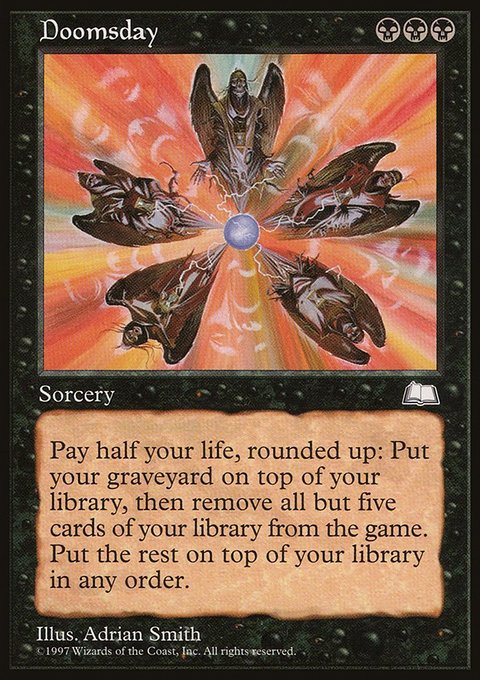



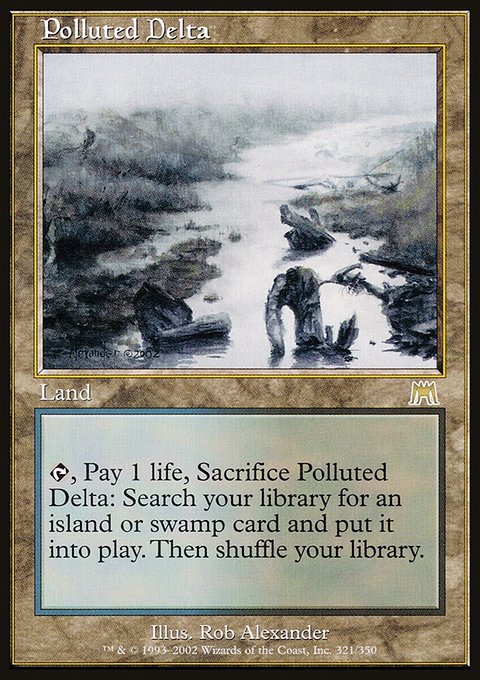

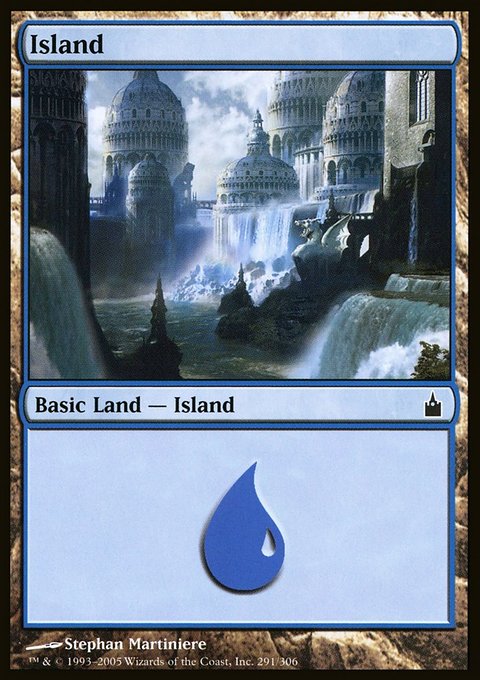
The sequencing would be play Top off of Island on turn 1. Turn 2 you would fetch Swamp with Delta, cast Ritual into Ritual and then Doomsday. You would then stack the basic pile listed above. Probe into Mental Note, mill Labman and X, draw and cast Probe into Unearth. Cast Unearth to reanimate Labman to then activate Top to draw for the win. An equivalent perfect draw from DDFT could result in a turn 1 win.








Take the same hand and replace one disruption element for another. You can play Delta, fetch Swamp. Ritual, Duress, cast Top. Ritual again to Doomsday stacking the SdT+Cantrip pile listed above. Cast Probe into LED. Cast LED. Crack LED for and activate Top to draw Ideas Unbound. Cast Ideas Unbound leaving in pool to draw Top, LED and LED. Cast Top for and cast both LEDs. Activate the LEDs for . Activate Top to draw Burning Wish, cast Wish leaving in pool and fetch Tendrils of Agony for 13 storm.
Regardless of any perceptions of the deck it was a new way to approach the archetype and did inspire many to try to concept (to no success) over the successive years whilst Top was legal.
From Delver to Delve
Skipping ahead a little bit, 2012 and 2013 did not bring too much to the deck or the meta other than the introduction of Young Pyromancer as another 2 drop threat for Delver shells. 2014 however was another significant year, both for DDFT and for the format in general. 2014 saw the release of Khans of Tarkir and with it, two very powerful spells being printed. Treasure Cruise and Dig Through Time. Many blue-centric archetypes easily adopted these cards in with eventually becoming the most popular build to make use of them. DDFT also was able to adopt both Cruise and Dig depending on the pilot's preference. Cruise was both a maindeckable tool and a draw 3 that could be found with Burning Wish. Dig allowed the efficient finding of combo elements. Because of the myriad of fetchlands, cantrips and the re-introduction of Lotus Petal into lists, Delve could be very quickly fueled. It once again gave DDFT another slight edge up over the other storm variants in being able to utilise these cards effectively.
This split possibility was useful in January of 2015 as Treasure Cruise was banned. Anyone who was previously on Cruise in DDFT could easily switch over to Dig and not feel too big an impact. For both styles of list, there were no real changes to the core of the deck other than adding the Delve spells with the win conditions and piles used remaining unchanged. Dig was eventually banned in late 2015 and DDFT returned to pre-Delve lists. Post Dig ban very little changes in lists for a few years. There are new printings that are tried out but mostly these represent new sideboard options, mostly for Wish targets. The core list does not really change and mimics very closely to those from 2012.
The King is Dead, Long Live the King
The start of 2017 seems very optimistic. Despite a low number of high placing results in events, there is still a decent community to the deck. The Stormboards gets its first makeover in a long while with old content archived away and a new navigation system and fresh graphics job. There is also the start of a project by user Bennotsi to begin writing The Doomsday Codex, a project that would soon enough evolve into the current Doomsday Wiki. Miracles is the current top dog of the wider Legacy metagame running Counterbalance and Sensei's Divining Top alongside Terminus and Entreat the Angels to devastating effect.
This optimism is swiftly removed with the following announcement from April the 24th 2017.
Legacy:
Sensei's Divining Top is banned.
April 24th saw one of the highest user rates on the Stormboards forums as people arrived to give their respects and ultimately say goodbye to both Top and DDFT as an archetype. New threads are quickly authored to try and re-work the archetype but the immediate mood is altogether low. Most storm lovers jump across to either TES or ANT leaving only a few foolish diehards to remain. A quote from user Oddmtg sums up the day very well:
I think I am switching to ANT. I'll definitely check in to see if Doishy can make it happen though.
— oddmtg
What's important to note here is that at this point Emidln had a lot of irl stuff going on. Between work and family matters he had been able to devote less time to Legacy and the forum/archetype in general. Because of my relative lack of commitments and my enthusiasm for the deck, I had stepped up to help moderate and subsequently administrate the forums. I was also now very active in the community online where possible and thus, when the ban hit, was one of the forerunners in trying to piece the deck and the community back together.
2017 post Top was quite a wild ride. People were trying all sorts of nonsense to see what worked. It was noted that Ideas Unbound was much worse without Top. Simply taking an existing list and replacing Top with Preordain didn't work as many of the piles relied on the mana efficiency that Top provided. I myself became convinced that running a straight list with Lim-Dul's Vault, maindeck Tendrils and Lake of the Dead to help power out draw 4s was the way to go. The list was fun but it certainly wasn't competetive by any stretch. It was Bennotsi and G0ld_rook who started properly trying out Three Wishes and starting everyone on the right path. Three Wishes enabled the creation of a double cantrip pile that didn't have to worry about the discard clause of Lion's Eye Diamond. It did mean an increase in pile cost compared to Ideas Unbound but was found to be pretty efficient.
Cantrip +
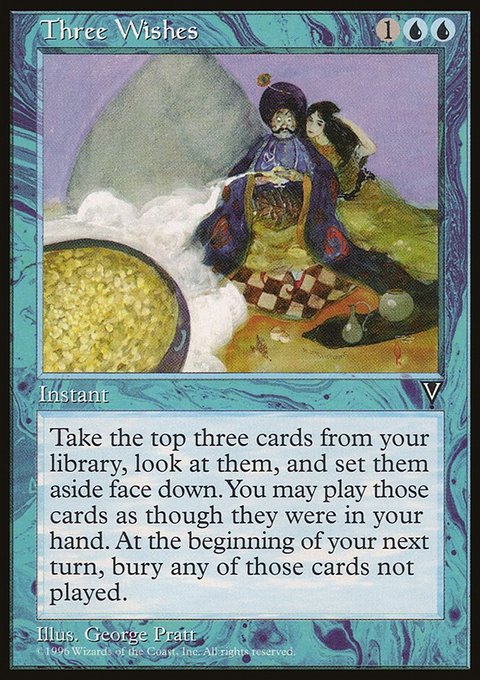




2 Cantrips





2 Cantrips





Back in M14 a card had been printed which had been considered by Emidln and other members but had been found to be lacking. With the successful testing of Three Wishes by a lot of the active members, it was a Japanese player who first tried the next the key to success. Suzuki Yuuto (Singpanman on MTGO) is a Japanese player who had gained a reputation from users on the Stormboards for playing some really spicy DDFT variants. He has been seen to be trying all sorts of nonsense however one particular card that appeared was taken note of. That card was Act on Impulse. Act provided the exact same effect as Three Wishes however was both easier to cast, only requiring a single coloured mana as opposed to Three Wishes' double requirement meaning it was easier to cast off of a ritual effect, and it was immune to Pyroblast style effects which were very common in Legacy. Active users like d8dk32 and G0ld_rook tried it out and gave it the thumbs up and eventually everyone jumped on the bandwagon.
Alongside the adoption of Act came the second coming of an old Legacy Doomsday staple from the very early days of the format; Conjurer's Bauble. This had been suggested early after the Top banning as the most likely candidate for replacing Top as a static draw effect but it wasn't given too much attention. Over this period of time I had been conversing a lot with Bennotsi about his Doomsday Codex project and started helping him write it (or re-write given the removal of Top references that were required). One evening over Facebook Messenger we started exploring the card and looking at one aspect of it that had not been fully considered, the looping potential.
Not only did Bauble allow for the same mana efficient plays as Top going turn 1 Bauble into turn 2 double cantrip win, it also acted as a defense against Surgical Extraction and could be used to loop cards back into a deck. Post-Doomsday this meant you could save a tool if it was countered or discarded or, actively use it to build storm. Bennotsi presented a number of pretty efficient piles, using Bauble to return an LED to the deck after use however I noted that actually most of them benefitted heavily from eschewing Burning Wish and being able to loop multiple baubles.
Bauble in Play + Cantrip

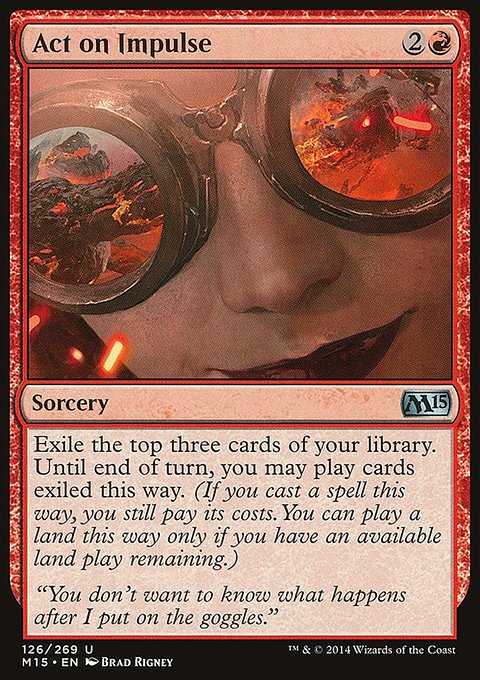



Bauble in Play + Cantrip





In the two examples above, the first gives 9 storm assuming you lead with Ritual into Doomsday. The second gives 10 storm with the same opening. Post Doomsday you cantrip into the first LED and then activate Bauble, targeting nothing, to draw and cast Act. Act exiles LED, Bauble and Tendrils. You cast LED and produce with it. You cast Bauble for leaving in pool. You activate Bauble and target the original Bauble in the graveyard. This puts the first Bauble onto the top of your deck and immediately draws it. You cast it for leaving in pool. You then activate it again targeting one of the LEDs in the graveyard. This you then draw and activate for the final needed to cast Tendrils.
With the tools of the trade re-worked and widely used, the Wiki was properly started to be written. Results started to be made again and new faces began to appear from discussion on reddit and mtgthesource. Community members like d8dk32, G0ld_rook and ApeOfJustice started regularly streaming increasing the visibility of the deck. A Facebook group was also made which attracted another slew of interested people. Everyone involved started to get to know each other and become as close to online friends as you can get. Bennotsi and I worked on the Wiki and this became the central information repository for the deck allowing people to easily find out how to learn it without having to trawl through the old forum posts on the Stormboards. As we entered 2018 the Doomsday Discord server was created. Originally intended to supplement the Stormboards with more instantaneous chatter it inevitably came to replace it entirely.
A fun little aside. Two Discord servers were actually created in the same evening. One by me and one by Wolfgang13. The current one used is the one Wolfgang13 made and passed ownership over to me.
This discussion forum and active re-working of an archetype really brought the community together with key members like Angrybacon, 8bit9mm, Luchius, ElDorte and Hulahula to name a few all working together to build upon the deck. It really felt like a second Golden Age, if not in actual results, at least in community culture. Overall despite the rocky start of 2017, 2018 felt like a really good year for the deck.
Fuck You Wizards
This section should have a more thematic title however I am going to allow myself the luxury of a little bit of bias here. In July 2018 we saw the banning of 2 key cards of the format; Deathrite Shaman and Gitaxian Probe. There had been rumblings of Probe being a card that was under scrutiny and many people in the format seemed to attribute it to causing the domination of the storm archetypes ANT and TES. In actual fact, as with most of the post-2011 bannings, it was the Delver archetypes that used the card to greatest effect combining it with Cabal Therapy and Young Pyromancer. I still think they should have banned Deathrite and then waited for the format to settle but nope, it was not to be. I had always said that I did not think the deck could be effectively run without Probe and that I would likely have to drop the deck if it ever went. Well, I guess someone wanted to see if I kept my word. For me the Probe ban hurt a lot more than the Top one as it almost single-handedly invalidated the work I had spent the last year performing. All the Wiki entries I had written, the community results spreadsheet we had built and tracked stats from, the community we had grown all fell apart in one day.
Once again a number of people jumped ship, myself included, and moved to other decks. Mostly ANT or Omnishow variants it seems. The main difference from the Top ban is, unlike the Top ban where many people left the forums never to return, many of the community members stayed. The server stayed running and people had fun trying to brew new lists with no illusions that they would be good. The friendships that had been made during the post-Top ban, pre-Probe ban era managed to stay despite the deck being lost. There was pretty much only a very small handful of people left who still earnestly tried to make Doomsday work and the spotlight now has to shine on the best of them; d8dk32.
d8dk32 (d8 for short) is an absolute legend. When everyone else drifted away from the deck he just kept trying to make it work. During this period we saw draw 4 lists re-emerge from him. Spanish Inquisition style lists, even Nic Fit based lists. The man just didn't stop working on making the deck work. It might be this work that actually helped keep the sense of community focussed and ready for the next iteration of the deck that would appear in late 2018 and early 2019.
DD-EF-T? An Experimental Frenzy
2018 saw the printing of the Guilds of Ravnica set which included a card called Experimental Frenzy. Frenzy was a card that had some cool potential to it and a few people decided to have a go at trying it out. It was reversemermaid at the time who first took it out for a spin. They were drunk and chatting on the Discord server as they tested it. This was the output of their testing:
From the Discord chat log:
It should probably have a maindeck ToA and a draw 4 to make non-frenzy piles more viable anyhow with frenzy in play the easiest pile is so darn stupid lol, [LED, LED, LED, LED, BW] makes enough mana to BW for ToA and sac Frenzy
Waiiiiiiiit damn lol these piles have trouble generating enough storm lol just did that pile and storm count was like 7 man im doing some embarassing misplays with this
Shieet you can pull double doomsday piles out of your ass to generate storm with frenzy this is so cool at 4 mana sources you can ptt pile with [EF, LED,
LED, DD, ToA] Throw Healing Salve in the 75 and you can actually go infinite lol
Wait ToA gains life so [LED, LED, LED, ToA, DD] is infinite
Reversemermaid stumbled upon the foundations of a new version of Doomsday in Legacy. It was dubbed DDEFT (still pronounced the same as DDFT) or Doomsday Experimental Frenzy Tendrils. The idea of this version was it could do the same tricks with Act on Impulse as it's predecessor if need be but it also could just run 3-4 Experimental Frenzies as both a raw card advantage engine and combo kill. If you had a Frenzy in play and resolved a Doomsday you could build a deterministic infinite life-loss win with the following pile:
Frenzy in play





You cast each LED and cast Tendrils. This gains you enough life to cast the Doomsday at the bottom. You then restack the same pile but with the original Doomsday cast used on the bottom. Repeat until required. It was identified that the pile could be replicated using only Collective Brutality in place of Tendrils of Agony.
Frenzy in play



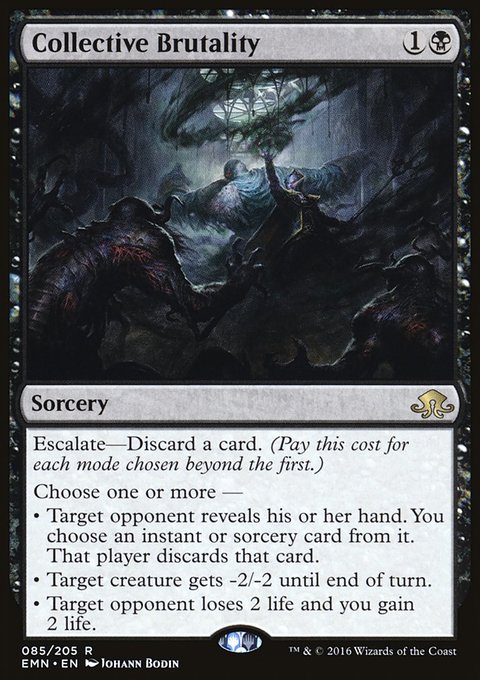

With the release of War of the Spark another new tool was introduced that could be slotted into the deck; Jace, Wielder of Mysteries. Jace allowed an alternative win condition which then could also provide long term card advantage. With Frenzy out you could also protect the card by stacking something like Flusterstorm underneath it.
Frenzy in play


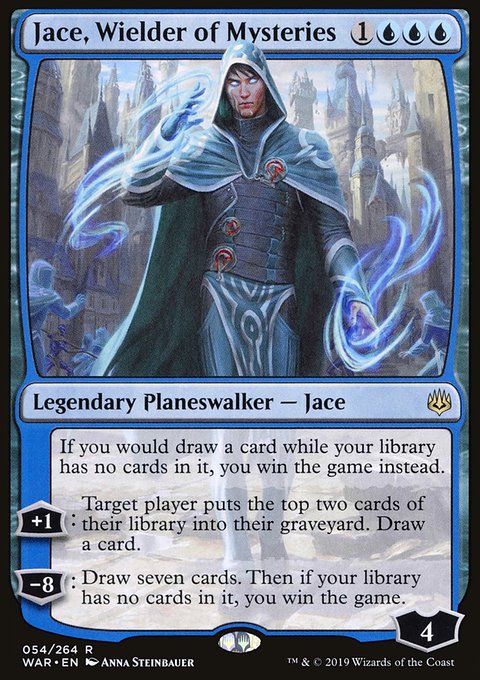
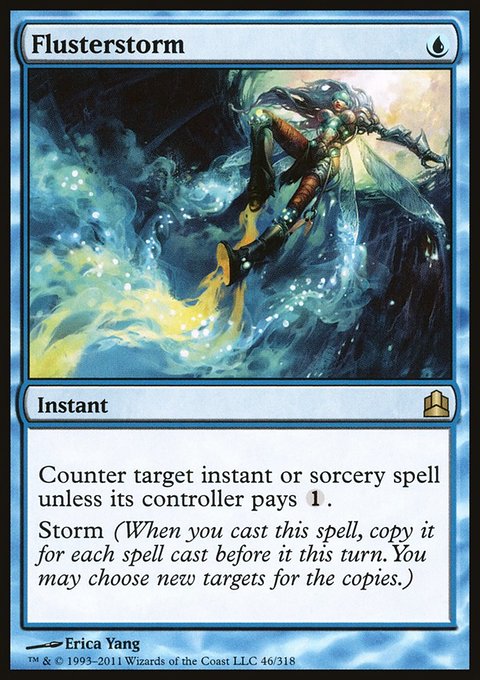

The deck did have some legs, even putting up good results in a challenge online and it had a good matchup against Grixis Control, one of the main decks of the time. It did suffer from a lack of consistency and a literal reliance on the top of your deck. Hitting a land or two in a row or another Frenzy often meant timewalking yourself a turn or 2. As a result, the variant was playable but not hugely effective compared to previous deck styles.
F.I.R.E but Still no D.D.F.T
We all know how the rest of 2019 goes. A lot of impactful new printings occur but almost none of them are applicable to Doomsday. If the storm kill was still being run then Veil of Summer would have been a nice consideration but it did not slot in well with the Frenzy version of the deck requiring another splash colour and being an awkward hit off of Frenzy. The only tool that was really tried out was Echo of Eons. Echo allowed for the building of piles that use Echo to Timetwister into your pile. This normally required at least one additional card in hand or some free mana rocks in play. d8dk32 was once again the leading man on giving this new tech a try writing a mini primer article on its usage. The list played Veil, as allowing a opponent to draw 7 cards is asking for disaster, and other than the Doomsday package, played very similar to other storm lists almost like an ANT and new TES style hybrid. As with many of the recent iterations of attempting revival, the deck seemed fun but overall lacking in raw power/consistency.
Meandeck Doomsday, Take 2
Theros Beyond Death was released in early 2020. Amongst the spoilers were 2 cards that caused me a lot of excitement. One was Underworld Breach and the other was Thassa's Oracle. Breach seemed like an incredibly powerful card (and it was!) which turned out to form an entirely new archetype by itself. The other gave teasings that my favourite deck, one I had neglected for about a year and a half (minus a brief stint trying to Frenzy people) could maybe come back again.
It was Monkeyscantcry who first posted results with a Meandeck style list in colours. People had been theorising lists but this was the first real showing of the proof in concept. It took a little while because a lot of the community were either playing Underworld Breach decks, myself included, or concerned that a format full of Brain Freeze was not a healthy one to be casting Doomsday in. With the banning of Breach, everyone's attention was finally able to be to diverted where it should. The printing of Oracle also saw the return of Emidln to the fold who returned by messaging me the following pile concept:
Thought Scour in hand
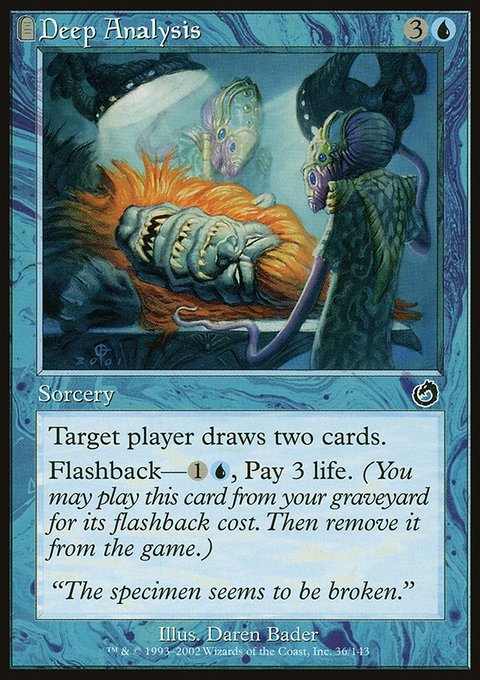



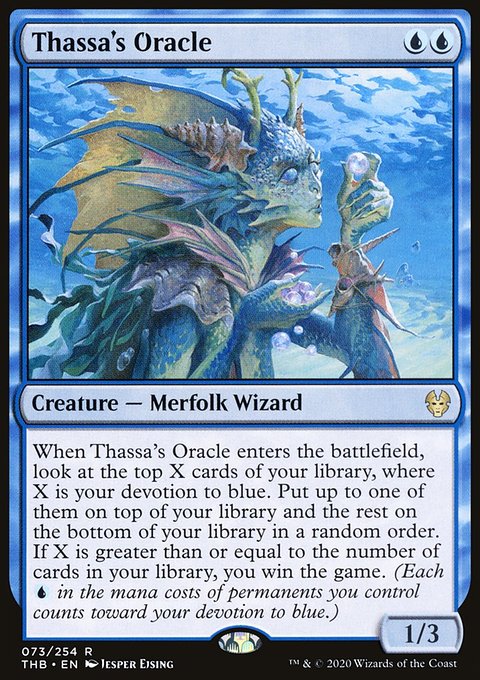
You use Scour to mill Analysis and X, draw LED. LED allows the flashback of Deep Analysis to draw Petal and Oracle. The entire pile, although graveyard reliant, is super mana efficient for a single . It was fun however, as the year shows, it did not catch on.
It's worth noting here that unfortunately Bennotsi had dropped off the Legacy scene for a while and, with Emidln gone, it was Angrybacon who took up the mantle of running the Wiki from a technical standpoint. Over the course of the last few years he had been slowly improving the backend, revamping the look and generally making it all much nicer. With Emidln back, we finally got some domain name transfer sorted to his new setup and I once again started writing furiously as the second coming of Meandeck developed.
Even with all the years of knowledge it still took a lot of trial and error to get things close to being right. Tech like Predict with Unearth was tried, cards like Counterbalance were given a go. Even spicy options like Divining Witch were given a run. Early on the shell seemed to be viable in either for Veil and Abrupt Decay or for Teferi, Time Raveler and Monastery Mentor. The list could be run as either a normal dual land manabase or an Arcum's Astrolabe reinforced snow one. With the build of momentum for the deck, many old pilots came back to the deck. Hulahula, Nevilshute, Emidln and Monkeyscantcry all started putting out good results online as corona-virus lockdowns started to be initiated. Thanks to this new surge of results coming in and availability of testing, tech like maindeck Cavern of Souls was widely adopted having first seemed like a sideboard slot at a stretch, it obtained widespread acceptance and Predict was ditched back to favour the old faithful; Ideas Unbound. Thanks to testing from community member and well known player Jax, Daze was integrated into the lists due to the speed with which the deck could win. Tinkering of things like number of free cycle effects were tried and eventually a mostly stock list structure was formed and piles were worked out.
Brainstorm + 1 card in hand


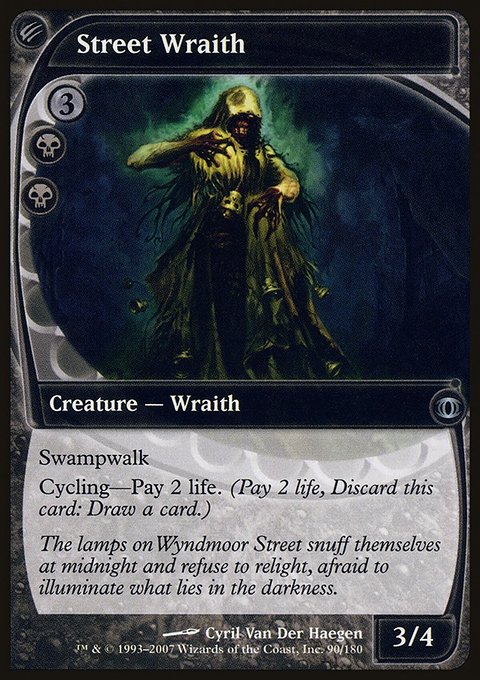


Cantrip +


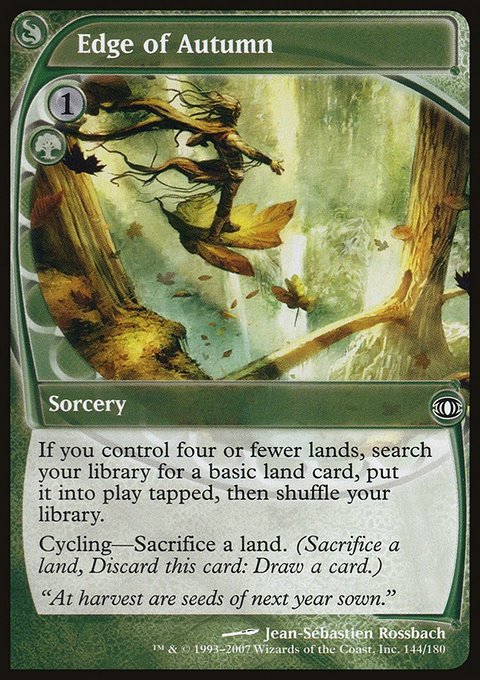
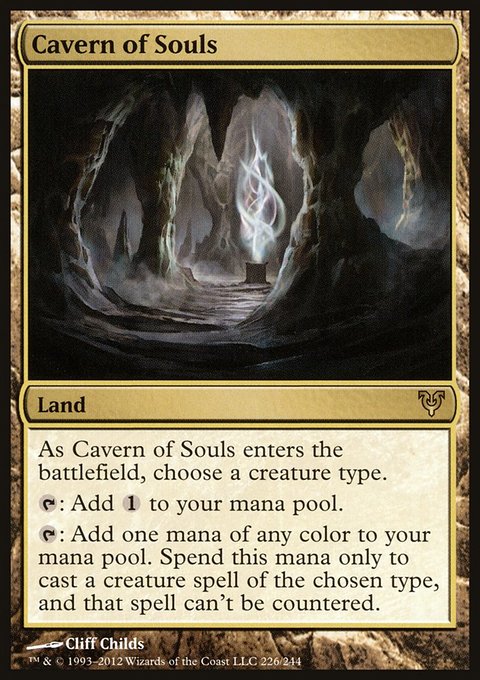

With the printing of Lurrus of the Dream Den from Ikoria, Doomsday was easy to accept the companion losing only access to Street Wraith and Teferi in the card pool. Using tools like Mishra's Bauble to gain card advantage with Lurrus or to delay dig into piles, it was able to stay toe-to-toe with the majority of the other Lurrus based decks and Zirda/Gyruda decks that were popular at the time. Nevilshute put up a lot of results in this time and started looking at the viability of a Grixis manabase running maindeck Pyroblast effects. When Lurrus was banned, Nevilshute, along with friend Sawatarix (Kai Sawatari) proved the viability of the red splash in the list. The deck was now shown to be able to run basically any colours and any toolbox it wanted. Over the year, very well known players like Marcus Ewaldh and Maxtortion have now jumped onto the deck.
If part of 2011 had seemed like a golden age, 2020 has definately been a platinum age for the deck. The community that stuck through 2 significant bans and stayed together were ready to go with all the infrastructure for the Discord and Wiki in place to launch into the new style of lists. This meant there was already active discussion and content very early on for all the new players looking into the archetype and a welcoming group to join. The year has seen the deck go from strength to strength proving to be a very powerful archetype with favourable results against 7 of the top 8 most played archetypes across the year. Honestly, if it wasn't for Delver of Secrets existing, it very well would likely be the best deck in the format.
It's at this point we come to the current time in December 2020. Commander Legends is out and the printings of Hullbreacher and Opposition Agent have not affected the deck really at all yet. Results are still being shown and the community is thriving. All in all, it seems to be going well. Hopefully Wizards will let us have this win for a bit longer.
Honourable Mention - Entombsday
One deck that was discussed in the interview with Emidln that I have not covered yet here is the introduction of the deck Tin-Fins in 2012. The deck was another storm variant in some ways relying on Shallow Grave and Goryo's Vengeance to reanimate a Griselbranned. This would then draw more cards to play a Lotus Petal or Chrome Mox to ritual or Entomb-Grave a Children of Korlis. This would enable life gain to draw more cards with. You could win through haste attacking for 22 with Emrakul and Griselbranned or storm off with Tendrils. The deck was an all-in graveyard combo which could run a storm finish. Now some people decided to try running Doomsday as a sideboard plan for the deck adding a Shelldock Isle and 4 Doomsday along with some other bits. It was pretty successful, both with and without the transformational sideboard plan. It ran all the way up from 2012/2013 but, like many other decks, had some decline to it.
In 2020, one Doomsday community member called Walkedairplane or Walked, had a go at what they called a "memestream or real deal?". The concept was to instead of take a Tin Fins list and add Doomsday to it, you start with a 2020 Meandeck Doomsday list and fit the Entomb-Griselbranned package to it. He ran it to strong success with solid performances even in open decklist events. As with any good Legacy deck it had a number of suggestions for its origin including Dimir combo, 5 card monte, DDTF - Doomsday Tin Fins but it was finally NichP who came up with the moniker Entombsday and it stuck.
Closing Thoughts
This was a lengthy piece to write but a thoroughly enjoyable one. Trawling through many old forum posts, chat logs and articles/videos has made me appreciate how much consolidated information hubs are. I am actually glad that we've moved away from the forums of old, despite the nostalgia, as trying to find anything in them is a real pain requiring the mixed used of search function and manual dredging through to find the exact time point you want.
I want to give a huge thank-you to Emidln for providing me with the information about the archetype and for helping innovate and work on the deck and community throughout its lifespan. I also want to thank all the people over the years who have stuck with the deck despite everything it has gone through. It doesn't matter if you joined the community in 2010 or in 2020, anyone who has participated in positive discussion, helped test ideas, produced content such as videos or streams or just made any new people feel welcome; Thank you for being part of it! Special thanks also go to Nanda/Namida/AgyePA who has been on the deck since 2011 and who has been an excellent friend/ ideas discussion partner for me over the years despite the geographical location difference!
If you haven't yet, please feel free to watch / listen to the interview with Emidln that can be found linked at the top of the page. The edited version was produced by OtterLady (@justthefastest on Twitter) with help from Hulahula.
Until next time.
Learn from the past and look to the future!
For more content, please check out our resources page which includes a list of community streamers. If you would like to submit content to the Wiki, feel free to reach to us in the Doomsday Discord.